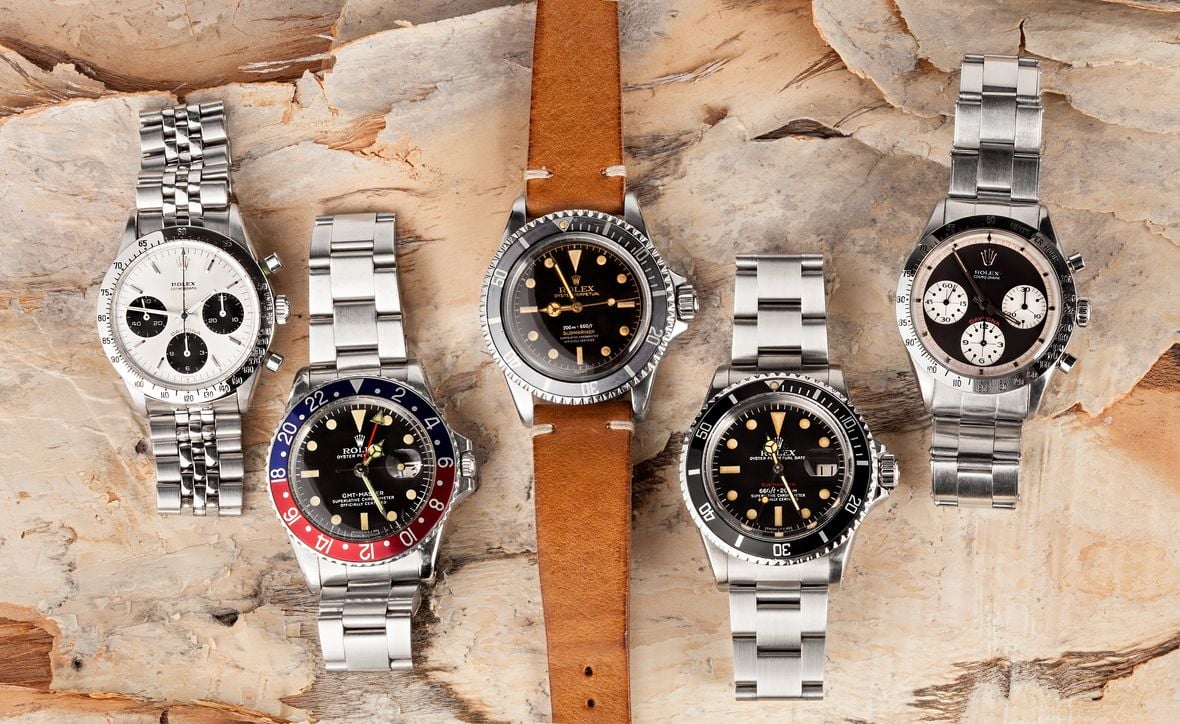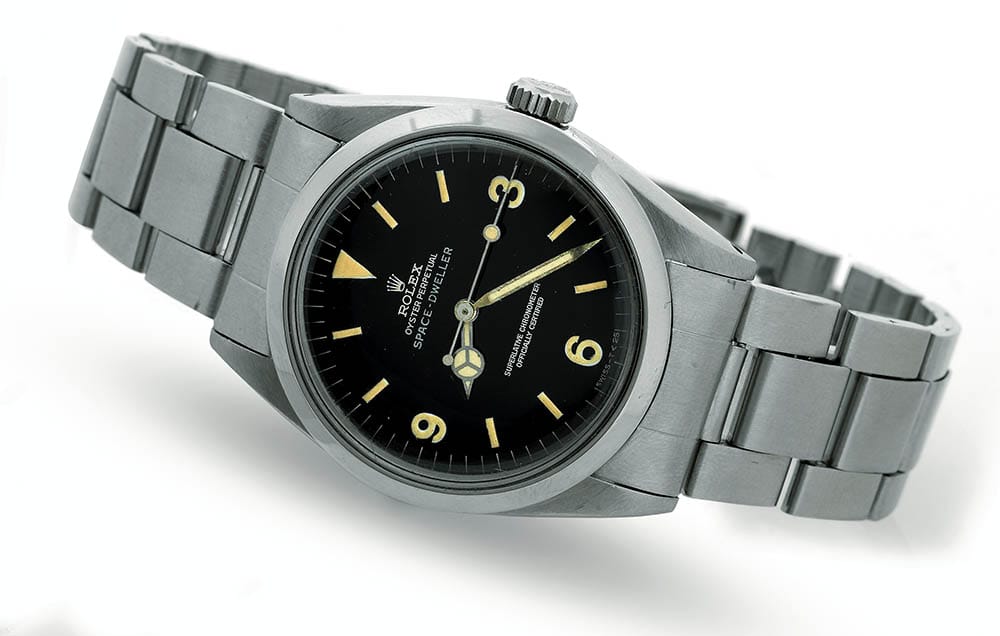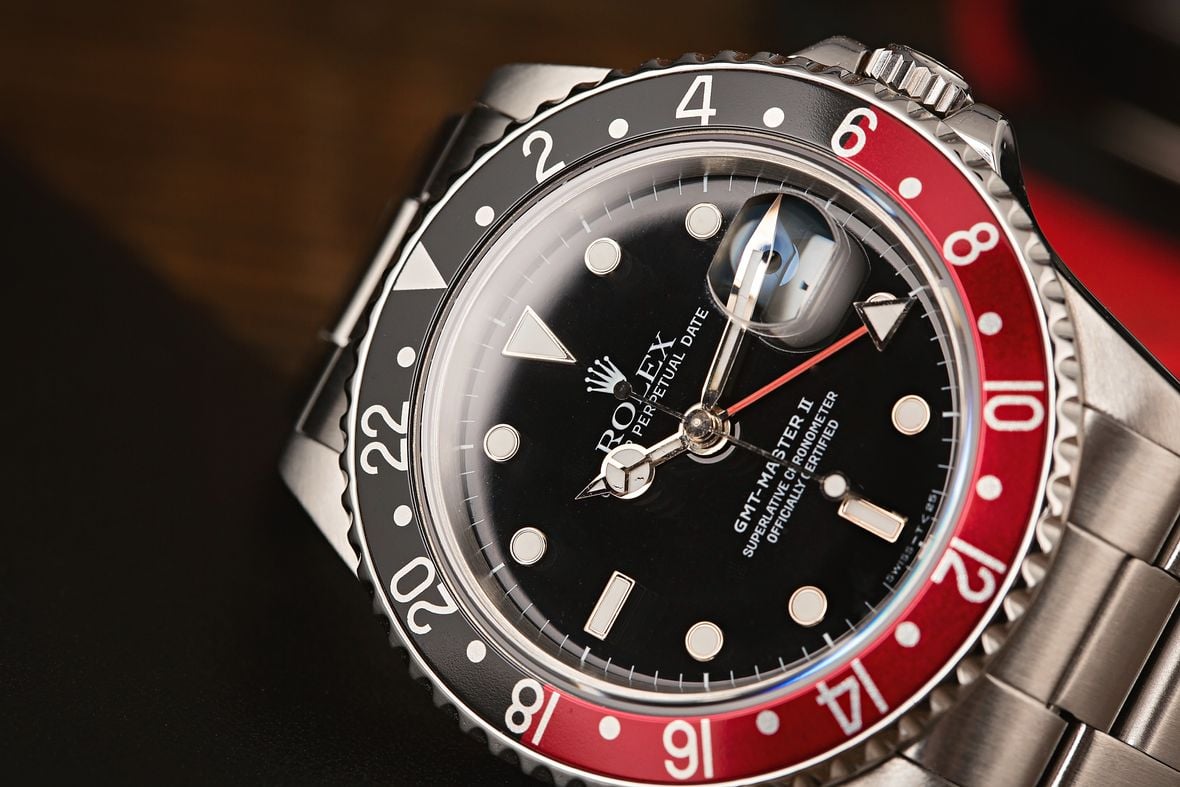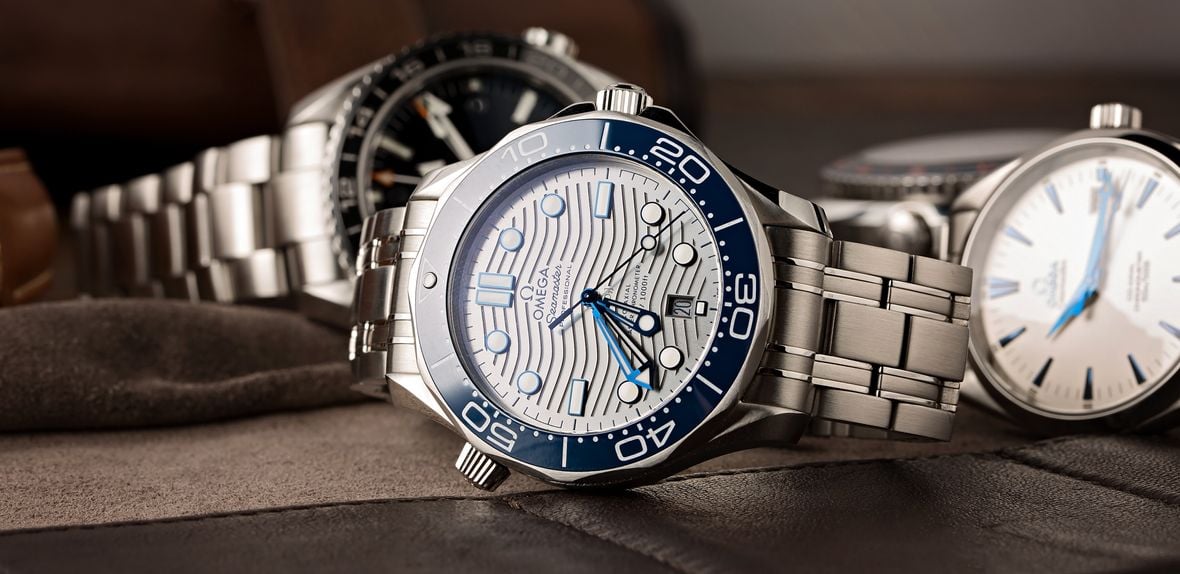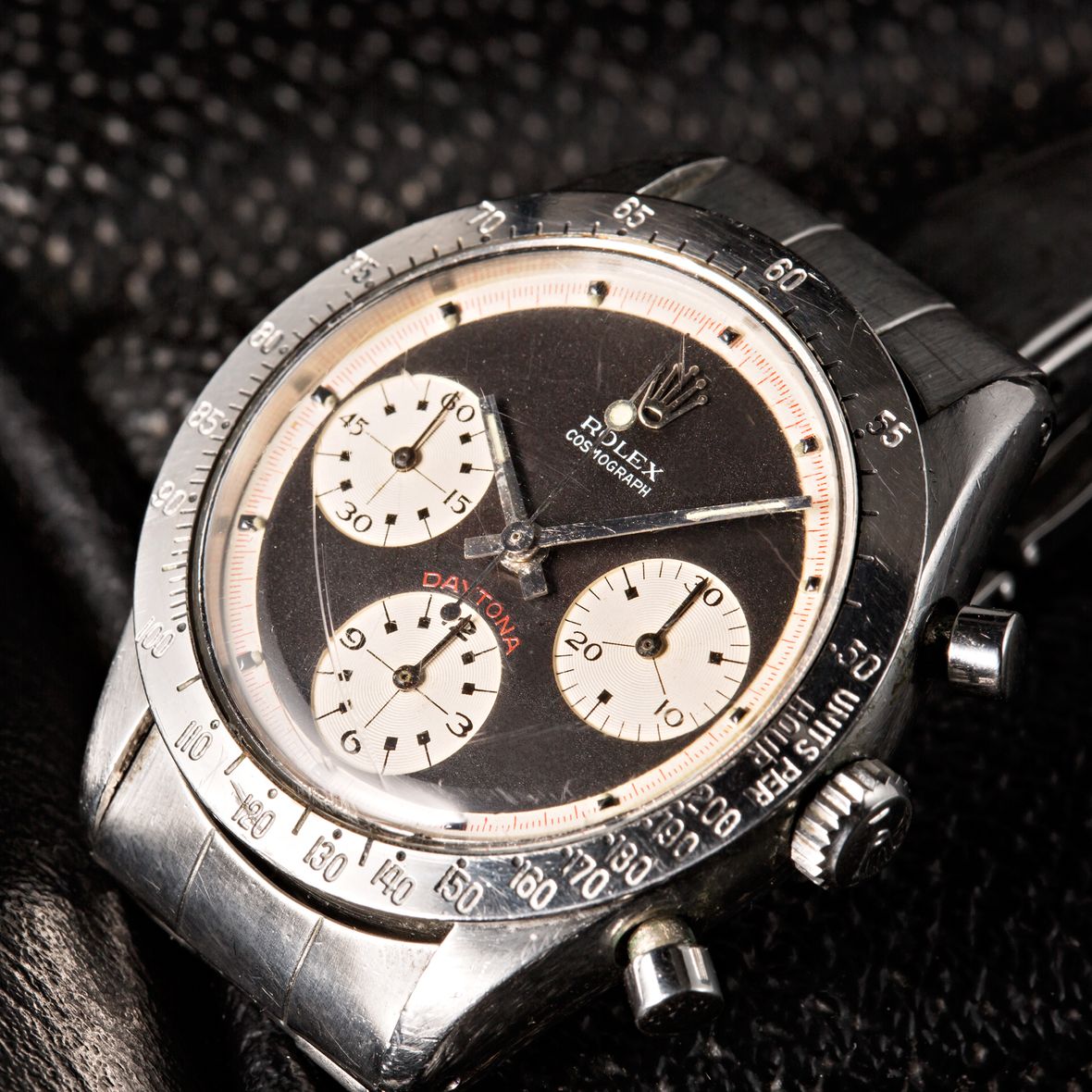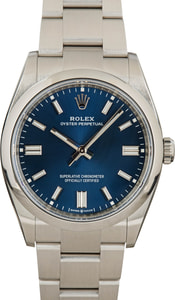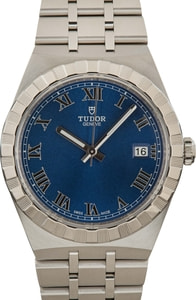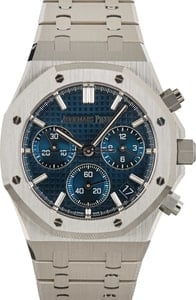For the vast majority of people in the world, it is virtually impossible to come up with anything but Rolex when asked to think of the first luxury watchmaker that springs to mind. It really doesn’t matter whether you are a “watch person” or not, the brand name is so inextricably linked to the notion of superior timepieces that the two are practically inseparable.
Rolex’s reputation is the end result of more than a century of exhaustive commitment to innovation, quality, engineering excellence, and brilliant marketing. There is a reason everyone is familiar with the name “Rolex” – and intelligent promotion is a key part of it. You will find a collection of Rolex watches on the wrists of just about anyone who’s anyone, past or present, real or fictional. Notable owners have included everyone from celebrities like Steve McQueen, Elvis Presley, and Paul Newman to world leaders and public figures like Dwight D Eisenhower, JFK, and Martin Luther King, and JFK. And with a customer roster like that, who wouldn’t want to join them?
Buying your first Rolex is a rite of passage, a milestone that is often associated with a major success in life. Therefore, it is important to get it spot-on. However, no one said buying a Rolex was going to be straightforward. There are more than 1,000 different models in the current catalog, spread across men’s and women’s watches, split into two main categories, and spanning more than a dozen different collections. On top of that, the manufacturer offers an extensive selection of different bracelets, bezels, and dial types, as well as a wide variety of metals for the watch itself.
Choosing the right Rolex is an involved and often confusing process, and so we have put together this comprehensive guide on the subject, taking in all the innumerable factors to consider to ensure you end up with the perfect model for you. So just how do you buy a Rolex watch? We’re going to start at the very beginning with a brief introduction to the brand, and see just how it got to its present world-beating status.
Rolex Watches
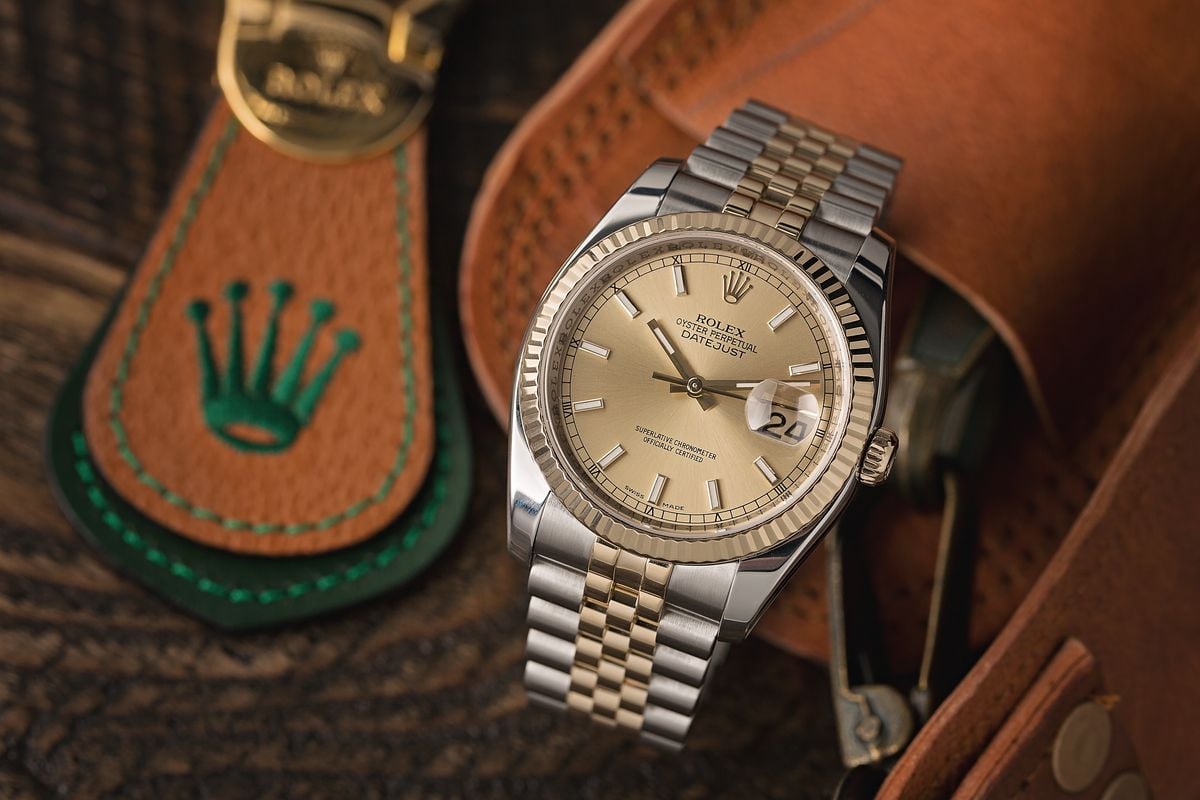
Rolex Key Facts:
– Founded in 1905 by Hans Wilsdorf.
– Headquarters in Geneva, Switzerland.
– Owned by the Hans Wilsdorf Foundation.
– Created the first waterproof watch in 1926.
– First self-winding Perpetual movement in 1931.
– Total production of approximately a million watches per year.
– Sold in more than 100 different countries.
Click here to learn more about Rolex.
History of Rolex Watches
The company which would go on to become Rolex was first founded in London back in 1905 by Bavarian entrepreneur Hans Wilsdorf. In partnership with his brother-in-law, Alfred Davis, the fledgling business of Wilsdorf & Davis first began not as watchmakers, but rather watch importers. The firm would buy in pieces from all over Switzerland and the U.K. and then sell them to a network of retailers. Those jewelers, more often than not, would print their own names on the dials. If the W&D logo appeared at all, it would be stamped on the inside of the case back.
However, Wilsdorf’s ambitions were far greater than that. After changing the company name to Rolex in 1908, the brand started assembling watches itself, taking the finest components from a variety of different manufacturers and compiling them together into a single watch.
Early victories for timekeeping precision followed. In 1910, Rolex won a First Class Chronometer Certificate from the rating office in Bienne, Switzerland. Then, in 1914, another example became the first-ever non-marine chronometer to be granted a Class A Chronometer Certificate from the Kew Observatory in England.
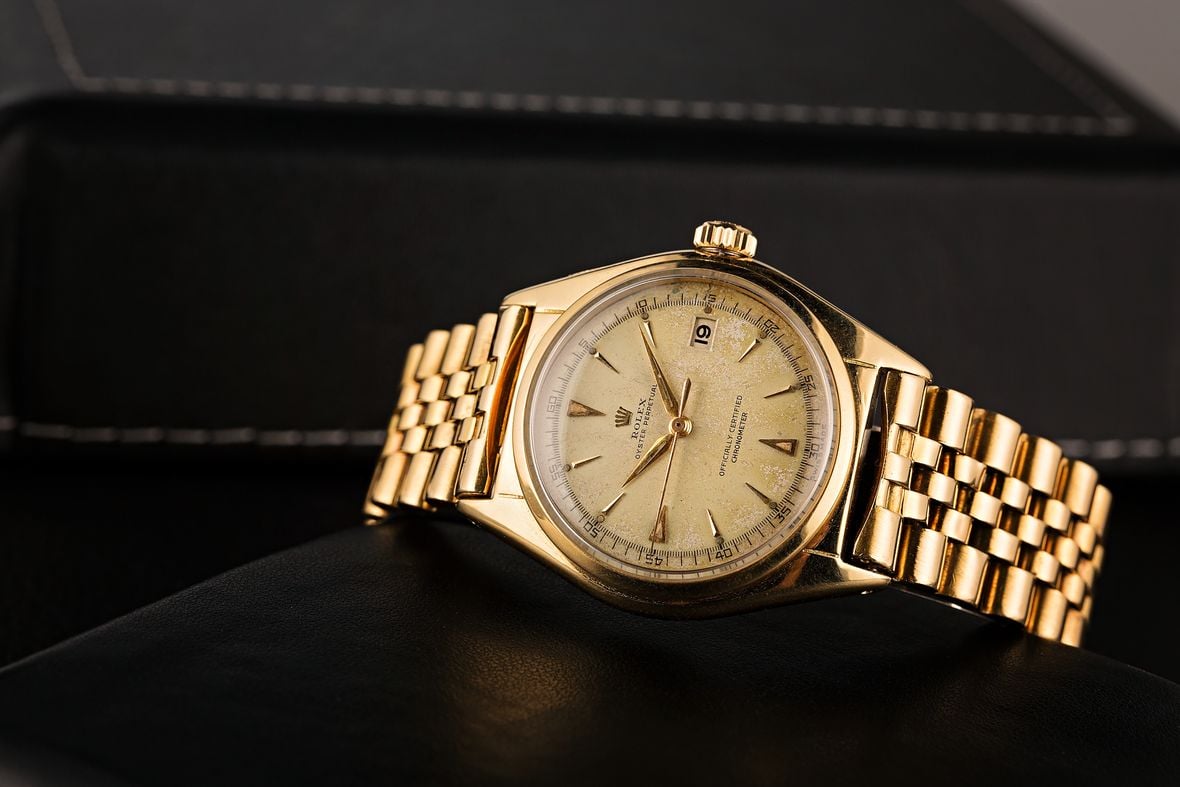
Key Innovations
With the Rolex name becoming synonymous with timepieces of the highest quality, Wilsdorf set about expanding his reach. In 1926 and 1931, he came up with arguably the two most important innovations the wristwatch has ever had in its entire history.
The first was a workable waterproof housing. Known as the Oyster, it was formed from a solid middle case, onto which the bezel, case back, and winding crown were screwed on to create an impenetrable shell. In one stroke, this solved the main problem that had accompanied wristwatches since their creation, namely their susceptibility to dust and moisture creeping inside and damaging the mechanism. With this new invention, the wristwatch suddenly became a practical item that could be worn every day, rather than being confined to fragile items of ladies’ jewelry as before.
The final part of the puzzle came a few years later when Wilsdorf perfected the automatic movement. Now, the motion of the wearer’s arm was the only thing needed to wind the watch, and the resulting device was dubbed the Perpetual movement.
Together, the Oyster case and the Perpetual movement formed the blueprint for just about everything Rolex made, and that is true even now, nearly a full century later. With the exception of watches in the Cellini range, every model in Rolex’s contemporary collection has a self-winding movement and is water-resistant to a depth of at least 100 meters.
Tool Watches
From the end of the Second World War, Rolex’s climb to the top of the horology industry’s ladder has been steady and consistent. The Datejust arrived in 1945 as the first automatically winding, waterproof watch with a date display. The watch became the brand’s biggest success thus far, but much more was to follow.
In the 1950s, Rolex brought the concept of the tool watch into the modern era. A term used to describe a timepiece that can do more than merely tell the time, a ‘tool watch’ typically has additional functions to aid professionals in their everyday life.
In quick succession, Rolex launched the Turn-O-Graph, Explorer, Submariner, GMT-Master, and Milgauss – all designed with extra utility in mind. More household names would join the list at later date, and Rolex continued to go from strength to strength with the likes of the Daytona, Sea-Dweller, and Explorer II offering even greater functionality.
Today, with such a litany of success, invention, and widespread appeal, Rolex is so far ahead of its nearest competition in terms of brand recognition that it is barely a contest. While tool watches still make up the bulk of the company’s portfolio, Rolex watches are seen far more as status symbols these days than earlier in the brand’s history. Buying and wearing one is a statement rather than a necessity, and it is often a sign that you have reached a certain level of accomplishment in life.
So, if you are in a position to join this exclusive club, let’s take a deeper look at what you need to know.
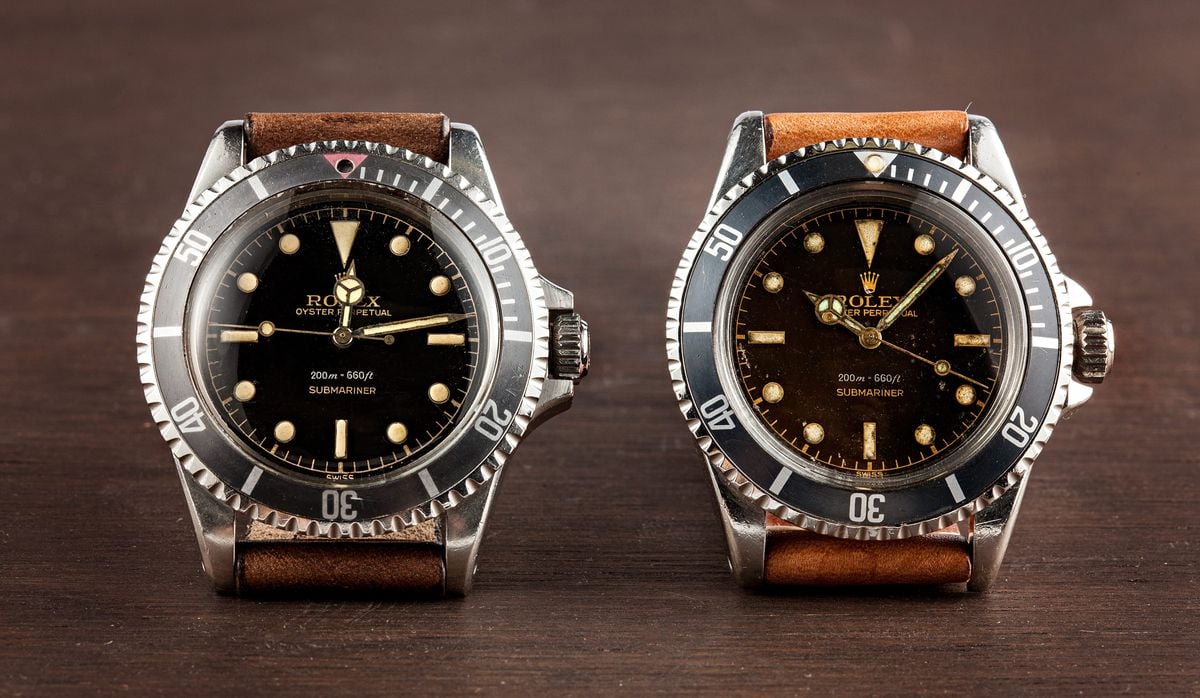
Buying Your First Rolex: Why and When?
Buying a Rolex – especially your first is an event and it is not something to be rushed into. The most common reason people buy Rolex watches is to celebrate a noteworthy occasion. It could be a graduation, a retirement, or a major business success. It might even just be to give as a gift; they can certainly make birthdays, Christmas, Father’s Day, or Mother’s Day very special indeed.
Another common motivation is the desire for that one ‘good’ watch – the one which will last a lifetime and be passed down to future generations. This is where Rolex truly excels. The brand’s watches might rarely be used to accompany extreme dive trips or see the world from Everest’s summit these days as they have in the past, but as far as strength, longevity, and reliability are concerned, you will have a hard time finding anything that outperforms a Rolex.
Lately, an increasing number of Rolex watches are being purchased as investments, particularly vintage examples. Although this is not something we would recommend as your primary investment strategy, there is no escaping the fact that certain models have exploded in value in the last few years. However, betting on that is a risky business and one that requires an extremely deep understanding of the brand. Once you have plenty of knowledge under your belt, the kind it takes years to accumulate, you will be in a better position to start speculating, but it’s best not to worry too much about this aspect when navigating your first purchase.
The best advice we can give in regards to when you should buy your first Rolex is to make sure you are in a strong enough position financially. Even the least expensive models will still represent a significant outlay, and so it is important to go in clearheaded. While the old adage of, “If you can’t buy it twice, you can’t afford it” doesn’t quite apply here, you will still enjoy your watch a whole lot more if you’re not constantly worried about how much you spent on it.
What Style of Rolex Should You Buy?
As we said at the beginning, Rolex divides its current range into two categories: Professional and Classic. The Professional Collection contains all the various sport and tool models, while the Classic Collection models are generally seen as the more dressy options in the catalog.
However, it isn’t actually as straightforward as you might think. Versatility is a word you will encounter a lot as you research your ideal Rolex watch. Many of the models that are listed within the Professional side of the catalog look perfectly at home as more formal wear, while there are plenty of models from the Classic Collection that are the definition of casual, relaxed style and work perfectly as an everyday watch.
For decades, Rolex’s commitment has been to create models that seldom look out of place anywhere, and this certainly holds true for most of the watches it produces. For example, despite being originally designed to be a professional dive watch, the Submariner is such an elegant, adaptable design that it pairs just as well with a tuxedo as it does with jeans and a t-shirt, or even a wetsuit (just ask James Bond).
The only caveat to this would be for the truly top-drawer pieces. Something like a Day-Date ref. 228396TBR, the flagship of the entire range, cast in pure platinum and drenched in diamonds from head to toe, is obviously a watch worn only on very special occasions and not when changing the oil on the car. Even still, this ultra-luxurious Day-Date offers 100 meters of water resistance, making it far better suited for daily use than most other watches that occupy a similar price point.
One of the biggest questions to ask yourself before you buy is how many Rolex watches you intend to collect in the long run. If you think this will be the only one, then a style with the most flexibility is a good choice. But if this is destined to be the first of many, you can afford to be a little more niche with your first purchase. More than anything else, what is most important is to buy what you love. Luxury watches are an emotional purchase and whichever one you choose, it will always be your watch. Make sure it is one that you will relish owning.
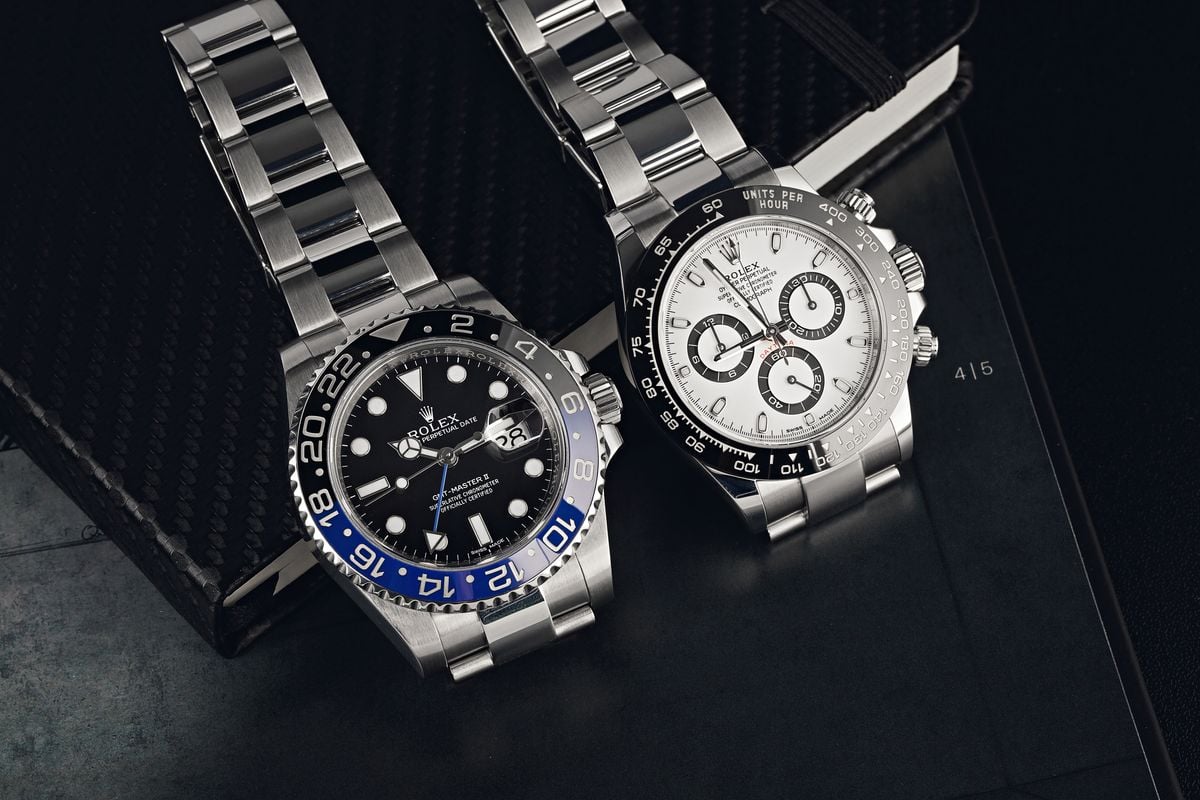
Rolex Watch Key Terms
Something else you will realize very quickly as you delve into the world of Rolex is that there appears to be a whole new language to learn. Over the years, an entire vocabulary has sprung up to describe the various aspects of the brand and its various watches. This ‘Rolexicon’ contains both official terms (coined by Rolex itself) along with a host of unofficial nicknames dreamt up by collectors, ones that make perfect sense to them and their fellow enthusiasts but are essentially meaningless to everyone else.
This list of formal and informal labels is vast, and there isn’t space to list all of them here. Many are also used purely to describe vintage watches, but below we have listed the most common ones you are likely to run up against as you research buying your first Rolex.
– Baton: A long, rectangular type of hour marker most commonly found on Rolex watches from the Classic side of the catalog.
– Bezel: The exterior ring that encircles the dial. Rolex uses several distinct types of bezels for various purposes and some offer additional functionality.
– Caliber: The more formal name for the watch’s internal movement.
– Chromalight: The name for the proprietary in-house luminescent material that Rolex uses on hands and hour markers to allow the watch to be read in the dark. Previous types of luminescent material have included; Super-LumiNova, LumiNova, Tritium, and Radium, the latter two of which are radioactive.
– Chronergy: Found in the new generation of Rolex’s in-house movements, the brand’s proprietary Chronergy escapement is a significant reworking of the traditional Swiss lever escapement, which offers an increase in efficiency and high resistance to magnetic forces.
– Chronograph: The name for a watch that can also be used as a stopwatch, usually with supplementary sub-dials to record elapsed seconds, minutes, and hours. Additional push buttons on the case (normally located on either side of the crown) allow for the timer to be started, stopped, and reset. Rolex’s most famous example is the Cosmograph Daytona.
– Crystal: The clear protective covering over the dial and hands. Now made from a synthetic sapphire crystal material, older vintage models featured crystals made from acrylic.
– Cyclops: The name Rolex gives to the small magnification lens set into the crystal above the date window to make the numeral easier to read. Provides a magnification of 2.5x
– Freccione: Unofficial nickname (meaning ‘arrow’ in Italian) used to describe the bright orange GMT hand on the original Explorer II ref. 1655. The current Explorer II model has reinstated the distinctive feature after it was absent for many years.
– Hack: A feature on all modern Rolex movements that stops the seconds hand when the winding crown is pulled out. This feature makes it easier to set the time accurately and allows for the easy synchronization of multiple different watches.
– Hairspring: An incredibly thin coil of metal that is mounted onto the balance wheel to form the watch’s oscillator. The hairspring is responsible for making sure the balance wheel swings back and forth at a precise rate, ensuring the watch’s timekeeping accuracy
– Helium Escape Valve (HEV): Developed by Rolex and fellow watchmaker Doxa, the HEV is a small one-way valve set into the side of the case at the nine o’clock. It opens automatically to allow trapped gases to escape, which may have built up inside the watch after prolonged periods spent in pressurized underwater habitats. Without it, the expanding gas can blow the crystal off the watch. Within Rolex’s catalog, helium escape valves are only featured on the Sea-Dweller and the Deepsea.
– Index: Another name for the various hour markers found on dials.
– Maxi Dial: A type of dial that has oversized indexes.
– Mercedes: The unofficial name for the type of hour hand commonly found on Rolex sports watches. The design is very close to the car manufacturer’s three-pointed star logo.
– Panda: A type of chronograph dial with a white, or light-colored background and black sub-dials. The opposite setup, with a black dial and white sub-dials is known as a “Reverse Panda” among collectors.
– Parachrom: Rolex’s proprietary hairspring material. An alloy of niobium and zirconium with a striking blue finish, it is exceptionally stable in the face of temperature variation, shocks, and magnetic fields, three factors that can greatly affect the accuracy of a watch’s movement.
– Polar: The unofficial name for a Rolex Explorer II with a white dial.
– President/Presidential: The President or the Presidential are informal nicknames for the Rolex Day-Date, gained through the model’s long association with some of the world’s most powerful leaders. However, although the President has never been used by Rolex to describe the watch itself, it is the official name for the three-semicircular linked bracelet created exclusively for the Day-Date in 1956.
– Rehaut: The name for the inner ring that fills the space between the dial and the crystal. On all modern Rolex watches, the rehaut is engraved with the serial number and the word ‘Rolex’ repeated around its perimeter.
– Rolesor: An official Rolex term for the use of stainless steel and gold components on a single watch (sometimes just called two-tone). Yellow Rolesor and Everose Rolesor models (which use yellow gold and rose gold, respectively) feature steel cases and outer bracelet links paired with a bezel, winding crown, and inner bracelet links formed from gold. On White Rolesor models, it is only the bezel is crafted from white gold.
– Sub-Dials: Most often found on chronograph watches like the Daytona, the sub-dials (short for “subsidiary dials” and sometimes known as sub-counters or totalizers) are typically used to keep track of the elapsed time when the chronograph is running. However, sub-dials can also display other information such as the date, running seconds, or an additional time zone.
– Super Case: A style of case Rolex introduced in 2005 featuring lugs and crown guards twice the thickness of previous examples. Despite having the same case diameter, the revised proportions provide the watch with more wrist presence.
– Syloxi: A new type of hairspring patented by Rolex made from silicon. Only found in the movements fitted to smaller, ladies and mid-size watches at the present time, it is believed to perform even better than Rolex’s Blue Parachrom hairspring.
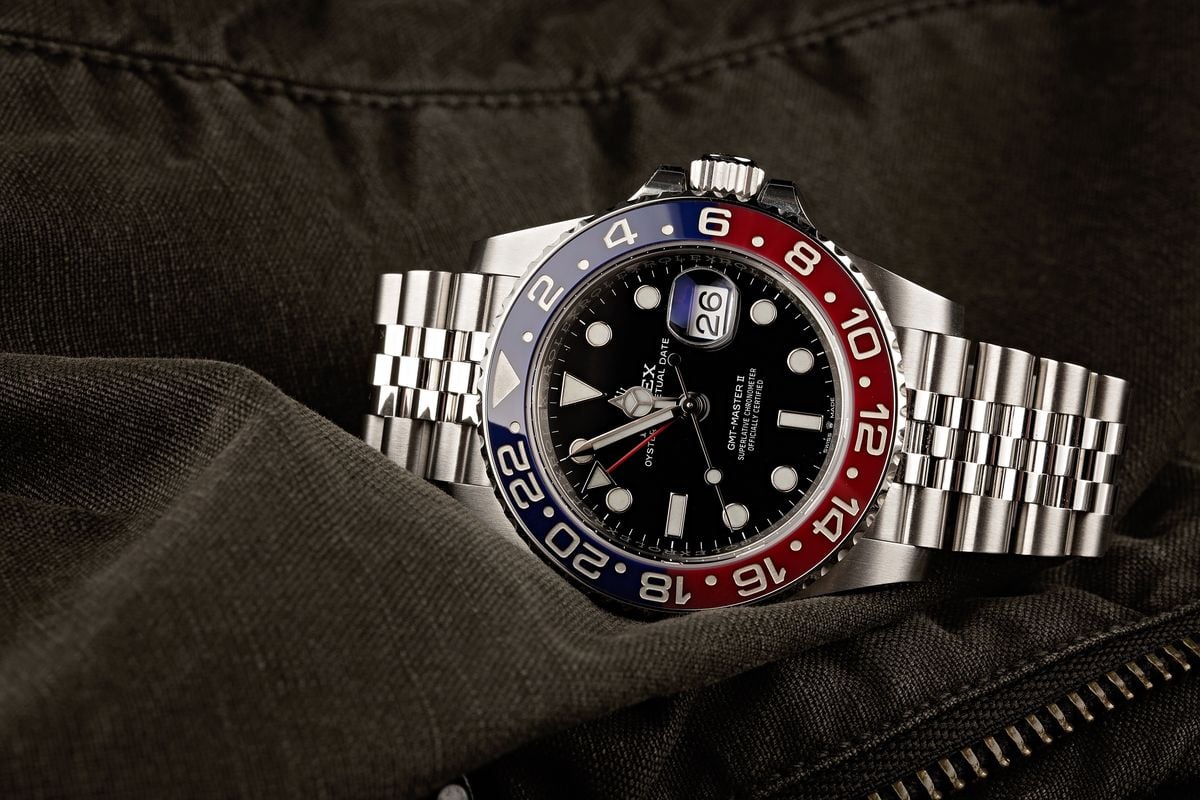
Tool Watch Nicknames
Two Rolex models, in particular, the GMT-Master and the Submariner have been given more than their fair share of unofficial nicknames over the years, and you will almost certainly come across them while shopping for your first Rolex. Each one is based entirely on the watch’s specific color scheme, and in most cases, it stems from the color of its bezel.
Rolex Submariner Nicknames
– Bluesy: A Yellow Rolesor Submariner with a blue dial and bezel.
– Kermit: A stainless steel Submariner with a black dial and green bezel. Originally, the nickname was given to the ref. 16610LV from 2003, brought out to celebrate the collection’s 50th anniversary. That watch was retired in 2010; however, a black dial/green bezel model was reintroduced in 2020 with a ceramic bezel insert and a larger 41mm case.
– Hulk: The ref. 116610LV Submariner that superseded the anniversary “Kermit” model. Along with a green ceramic bezel and Super Case design, the Hulk also featured a green sunburst dial. The watch was discontinued in 2020 but remains extremely popular on the secondary market.
– Smurf: The ref. 116619LB Submariner in solid 18k white gold and fitted with a blue dial and blue ceramic bezel. Also discontinued in 2020, it has been replaced by a new white gold model that now has a 41mm case and a black dial with a blue bezel.
Rolex GMT-Master II Nicknames
– Batman: A GMT-Master II with a bezel in half black and half blue. This color option is only found on ceramic bezel inserts.
– Batgirl: When the second generation of the black and blue GMT-Master II was released, it was exclusively offered on a Jubilee bracelet and featured a slightly more refined case, leading some to nickname the watch the “Batgirl” (however, there are others refer to all black/blue GMT-Master II watches by the same “Batman” nickname).
– Pepsi: The original and most famous color option for Rolex GMT watches. Pepsi GMT watches have bezel inserts that are half red and half blue, and they can be found on both GMT-Master and GMT-Master II watches and can be crafted from either bakelite, aluminum, or ceramic.
– Root Beer: Originally introduced during the 1960s in the form of aluminum inserts with a brown and color profile, modern Root Beer bezels are crafted from ceramic and are half black and half brown in color.
– Coke: First introduced during the 1980s on the very first GMT-Master II, Coke bezels are half red and half black in color and are only found crafted from aluminum. At the present time, the Coke bezel is not an option in Rolex’s current catalog.
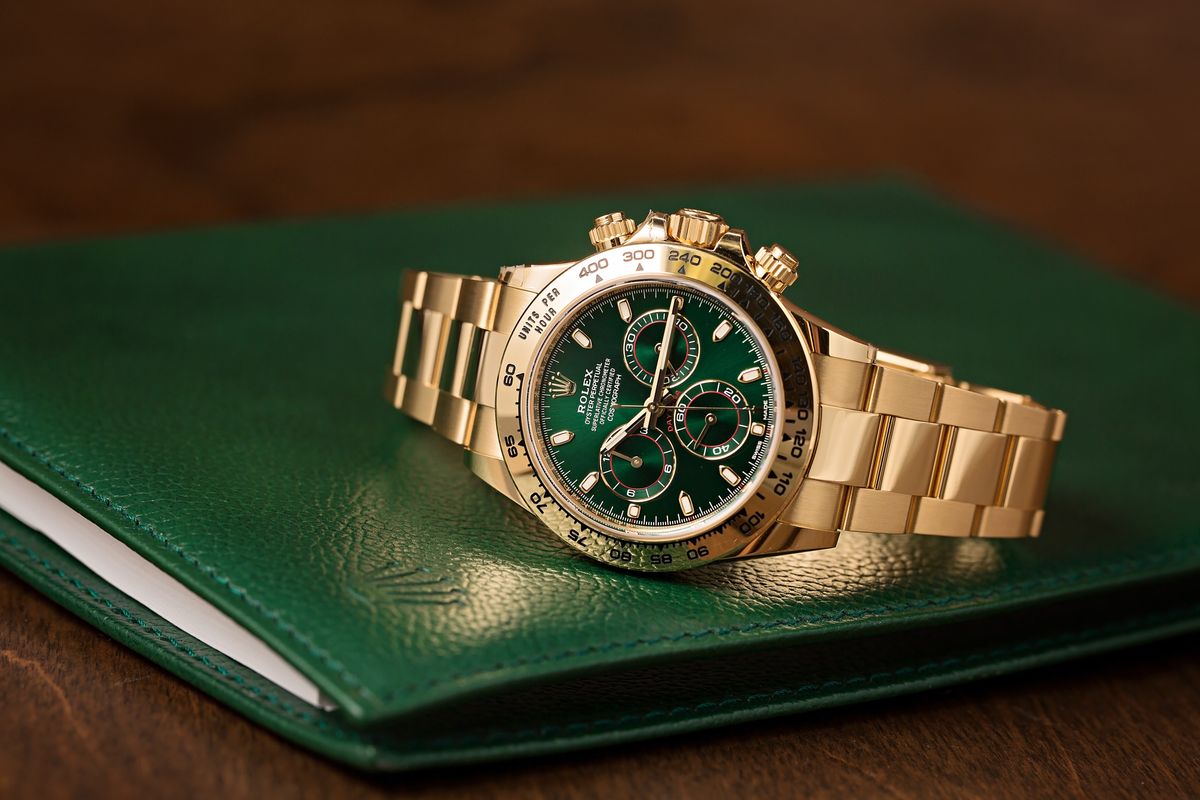
What Materials Does Rolex Use?
The type of materials Rolex employs in its watchmaking are absolutely vital to the quality of its output. As one of the most sophisticated and vertically integrated industrial facilities in the world, virtually everything the brand uses is made entirely in-house. Below, we list the various metals and alloys that go into a Rolex watch.
– Oystersteel: Rolex’s own name for the 904L stainless steel used throughout its range. Normally only found in the aerospace and chemical engineering spheres, it is incredibly hardwearing and resistant to corrosion. It is very expensive and especially difficult to machine, with Rolex just about the only manufacturer working with it. 904L steel also holds a distinctive polish, leaving the brand’s steel watches with a unique apperance.
– 18k Yellow Gold: Forged within its own in-house foundry (as is the case with just about every metal the brand uses), Rolex’s 18k yellow gold consists of 75% pure gold blended with silver and copper (along with small amounts of other elements) to harden the alloy and give it its characteristic hue.
– 18k White Gold: With the same ratio of pure gold as the yellow variety, Rolex’s white gold is mixed with primarily nickel and palladium to achieve its versatile monochrome color. Unlike many other white gold watches, Rolex does not use rhodium-plating to coat its white gold models.
– 18k Everose Gold: Rolex’s name for its trademarked pink gold alloy, Everose was initially introduced in 2005. It consists of 75% pure gold, with 23% copper to give the warm reddish tint, and 2% platinum to seal in the color and prevent it from losing its warm rosy tones.
– Platinum: Found only at the very top end of the Day-Date, Daytona, and Lady-Datejust lines, Rolex’s 950 platinum contains 95% of the pure metal, combined with ruthenium for added strength and durability.
– Cerachrom: While Rolex once used aluminum for the bezel inserts in a number of its tool watches, it was replaced in 2005 with a proprietary ceramic material dubbed Cerachrom. Extremely hardwearing, Cerachrom is also fade-proof and scratchproof, ensuring that it will stay looking brand new for decades.
– Rolesor: First patented in 1933, Rolesor is the brand’s name for a two-tone mix of gold and steel parts on a single watch. Available with all three colors of gold, the yellow and Everose variants have the bezel, crown and central bracelet links in gold, with the watch case and outer links in stainless steel. With the white gold Rolesor models, it is only the bezel that is rendered in gold.
– Rolesium: Another Rolex term for a mix of metals, Rolesium is a combination of stainless steel and platinum. First introduced in 1999, it has been exclusively used on the Rolex Yacht-Master collection in the form of a steel case and bracelet paired with a solid platinum outer bezel.
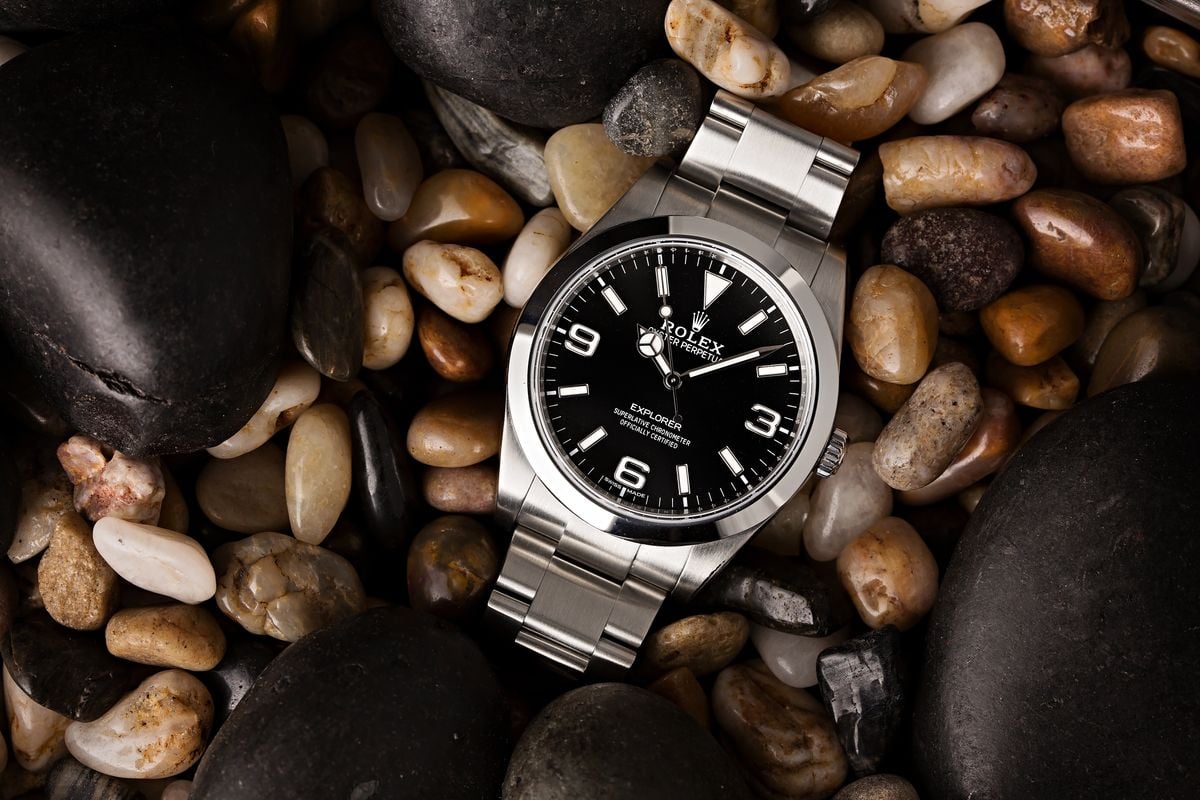
Rolex Bracelets
An element often overlooked by newcomers to luxury watch buying, the type of bracelet fitted to a watch has a huge effect on both its overall look and feel. There are five official bracelet types available on the contemporary range of Rolex watches, and each one has its own unique design and personality.
– Jubilee Bracelet: The oldest type of bracelet Rolex still uses, the Jubilee was created especially for the Datejust model when it debuted in 1945. With five semicircular links, it is also among the brand’s most intricate bands, lending a sophisticated air to the watches that are paired with it. However, the Jubilee bracelet is not restricted to just the dressier models, and you will even find it on the stainless steel versions of the current GMT-Master II
– Oyster Bracelet: Only very slightly younger than the Jubilee, the Oyster dates back to 1948. Its three flat links make it the most tool-like and casual of Rolex’s metal bracelets, and you will find the Oyster used extensively throughout the entire range, with many top models such as the Submariner, Air-King, Explorer, and Sea-Dweller only offering the option of Oyster bracelets.
– President Bracelet: As with the Jubilee, the President bracelet was made specifically for the launch of a new watch, and in this case it was designed for the Day-Date in 1956. With three rounded links, it is something of a halfway point between the Jubilee and the Oyster; however, it is a premium bracelet option and is only ever crafted from either solid gold or platinum. Although the Day-Date is commonly known as the President or Presidential, those are unofficial nicknames for the watch itself; however “President” is the formal name for the bracelet.
– Pearlmaster Bracelet: With its five rounded, staggered links, the Pearlmaster was introduced in 1992 for the first of the Pearlmaster watches, a range based on the Datejust and exemplified by their liberal use of precious stones. Like the President Bracelet, the Pearlmaster is a premium bracelet option, only ever crafted from precious metals and appearing on luxury-oriented versions of the Datejust and Day-Date.
– Oysterflex Bracelet: Rolex’s first rubber strap, the Oysterflex is actually made up of a nickel-titanium blade covered with high-performance, hypoallergenic black polymer. Used initially on the Yacht-Master series from 2015, the Oysterflex has gone on to be worn by both the Daytona and most recently the Sky-Dweller, phasing out the leather strap versions of both series. On the underside of the Oysterflex are a pair of raised vents, which allow air to flow through and stabilizes the watch on the wrist, and it is currently only fitted to solid gold Rolex watches.
– Leather Strap: These days, leather straps are only found on Rolex’s dedicated dress watch series, the Cellini. Available in black, brown, or blue and fitted with an 18k gold buckle to match the case of the watch, the straps feature a full-remborde edge and were most frequently made from alligator leather. Additionally, in the past leather straps were offered on a much wider range of watches, including select Daytona, Day-Date, and Datejust models.
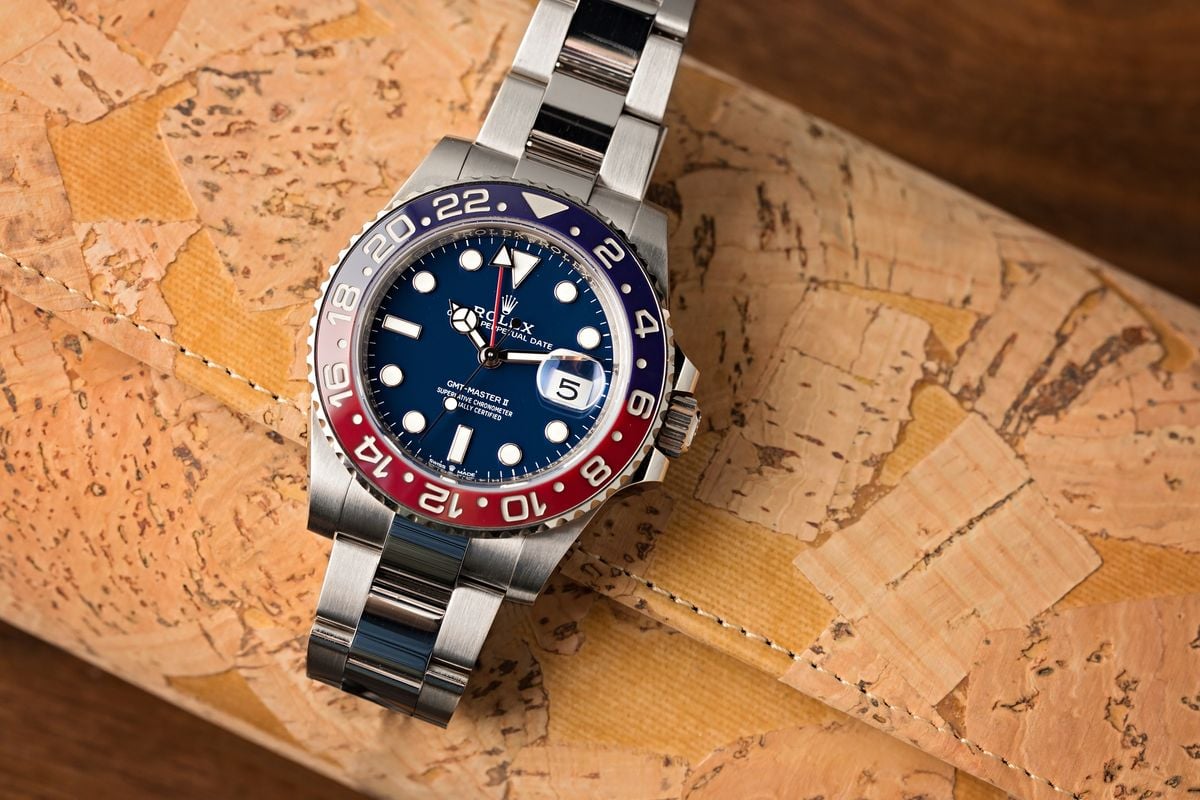
Rolex Clasps and Extensions
Securing whichever bracelet your Rolex watch is wearing is a vital consideration, and the brand offers three types of clasps to protect from accidental opening. The particular fastening is chosen based on the theoretical role each model – for example, a dive watch has a heavier-duty clasp than a dress watch.
– Oysterclasp: The simplest form, usually worn by the non-tool watch range. It features a latching folding clasp opened by a lever mechanism and embossed with the Rolex logo.
– Oysterlock: Similar to the Oysterclasp, the Oysterlock has an additional latch to safeguard against accidental opening during more demanding activities. Tough and reliable, this is the type fitted to the majority of the brand’s sports watches.
– Crownclasp: Introduced in the 1960s onto the Day-Date’s President bracelet, the Crownclasp provides a virtually seamless locking mechanism, giving the impression that the bracelet is a single, unbroken band. Only an embossed Rolex coronet fastener marks the join, and the Crownclasp can also be found on select versions of the Jubilee and Pearlmaster bracelets.
Clasp Extension Systems
Each Rolex clasp has a specific type of expander, allowing for the bracelet to be effectively lengthened or shortened quickly, easily, and without the use of any tools. Again, the kind of extension system is dictated by the type of watch and its intended use.
Non-sports models will need only a limited amount of adjustment to compensate for the slight swelling and shrinking the wrist goes through during the day due to fluctuations in temperature and hydration levels. However, the dive watches are designed to fit over the sleeve of a wet or dry suit and so they will require a much greater level of bracelet alteration.
– Easylink Extension: Developed in 1996 to allow for around 5mm of extension, the Easylink is fitted to most non-Professional models. It works by including an extra link beneath the clasp that can be either pulled out or folded under depending on whether you need the bracelet longer or shorter
– Glidelock Extension: Fitted to Rolex’s trio of dive watches, the Glidelock was invented in 2008 specifically to allow wearers to easily slip the watch over the sleeve of a dive suit. The internal toothed section under the clasp gives a total of 20mm of extension in 2mm intervals.
– Fliplock Extension: Only fitted to the especially rugged Sea-Dweller and Deepsea dive models, the Fliplock works in conjunction with the Glidelock and allows for an additional 26mm of extension, to allow wearers to fit their Rolex over the extremely thick sleeves of wetsuits or drysuits.
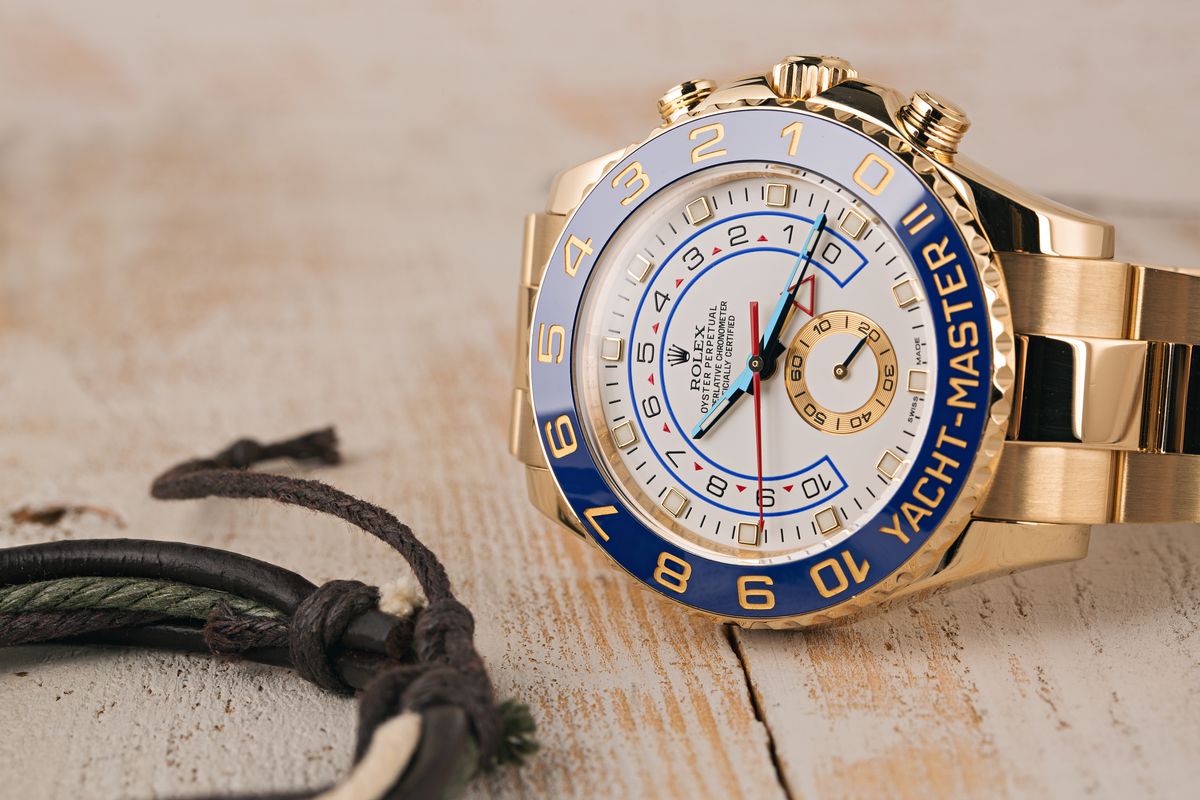
The Types of Rolex Bezels
Every Rolex watch has a bezel of some sort, its primary purpose being to secure the crystal onto the case to ensure a level of water resistance. However, after that task is out of the way, the bezel offers the perfect opportunity to add a distinctive style of decoration or to provide a useful additional function.
Rolex Decorative Bezels
Decorative bezels are those that do not offer any additional utility beyond holding onto the crystal, and whose primary purpose is largely to do with the aesthetics of the watch.
– Fluted: The fluted bezel is a design very much associated with Rolex and featured heavily across the Day-Date and Datejust ranges. Only ever made from gold, it features a series of gently undulating ridges around the entire perimeter that catch the light in a subtle but still noticeable way. Fluted bezels actually evolved out of the earlier coin-edge style, which provided a way for watchmakers to grip the bezel as they screwed it onto the case.
– Smooth: The simplest and most understated type, smooth bezels (sometimes called domed bezels) can be found across many of Rolex’s watch families, including the Oyster Perpetual, Air-King, Milgauss, and Explorer, as well as the Day-Date and Datejust. Free from any decoration and available in steel, all three flavors of gold, and even platinum, they are the most versatile form of bezel that Rolex offers.
– Gem-Set: Rolex employs its own team of master jewelers to outfit many of its watches with fine gemstones. Diamonds, sapphires, rubies, and emeralds can all be found on Rolex bezels, particularly among the luxury-oriented models from the Classic Collection. However, there have been a number of sports watches in the past with precious stones as well, including special editions of the Daytona, Submariner, GMT-Master II, and Yacht-Master.
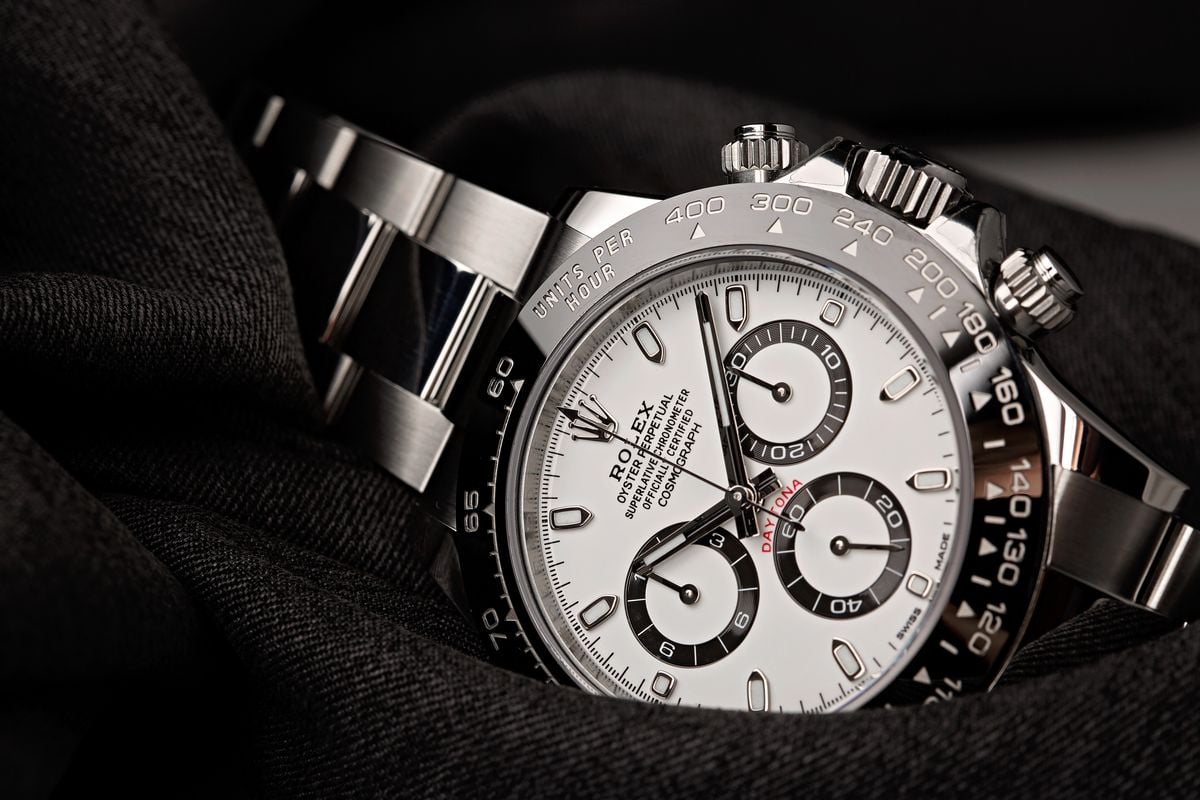
Rolex Functional Bezels
Functional bezels are those that add to the overall functionality of their watches and frequently feature various numerical scales engraved on their surfaces. They can either be fixed or rotating and are most frequently found on Rolex’s various sport and tool watch models.
– Timing Bezels: Rolex’s three dive watches; the Submariner, Sea-Dweller, and Deepsea (along with the Yacht-Master) are all fitted with a rotating bezel engraved with a 60-minute scale that can be used to track elapsed time. To start timing an event, the wearer simply lines up the bezel’s zero point (marked by an inverted triangle) with the watch’s minute hand. The amount of elapsed time can then be read easily off the bezel’s numerals.
– Dive Bezels: Dive bezels are just a type of timing bezel, but they are specifically intended to help keep track of time while underwater. Modern dive bezels often feature a luminescent pip in the middle to improve legibility in low-light conditions, and they also only turn counter-clockwise (known as unidirectional). This acts as a failsafe and guarantees that if the bezel ever gets knocked or moved accidentally during the dive, it will only overestimate immersion time, helping divers avoid decompression sickness. Additionally, all of Rolex’s modern dive bezels are now made from the brand’s proprietary Cerachrom ceramic material.
– GMT Bezels: Similar to dive bezels, GMT bezels are also engraved with numerals, but this time with a 24-hour scale. Found on the GMT-Master II and Explorer II, the bezel works in conjunction with those watches’ additional 24-hour hand, which is geared to run at half the speed of the regular hour hand. To keep track of a second timezone, the wearer simply sets the second hour hand to point to the desired hour on the bezel. The GMT bezel on the Explorer II is fixed and forged from the same steel as the rest of the watch. On the GMT-Master II, it is now made from Cerachrom and rotates in both directions (known as bidirectional), allowing the watch to track three different time zones.
– Ring Command Bezels: Found on the Yacht-Master II and the Sky-Dweller, the Ring Command bezel is linked directly to the internal movement. On both of these models, rotating the outer bezel locks and unlocks the watch’s various functions, which can then be adjusted with either pushers or the winding crown.
– Tachymeter Bezels: Found exclusively on the Daytona, the tachymeter bezel can be used to accurately measure speed over a set distance (or distance if traveling a constant speed). The engraved scale converts elapsed time into average speed, essentially by dividing 3,600 (the number of seconds in an hour) by the number of seconds it takes to travel a certain distance. To calculate average speed, simply start the Daytona’s central chronograph hand at the start, and then stop it once you complete a mile. Where the hand points on the tachymeter scale will correspond to the average speed traveled over that mile. The tachymeter bezel on the Rolex Daytona can be crafted from either gold, platinum, or Cerachrom, while discontinued models can also be found with stainless steel tachymeter bezels.
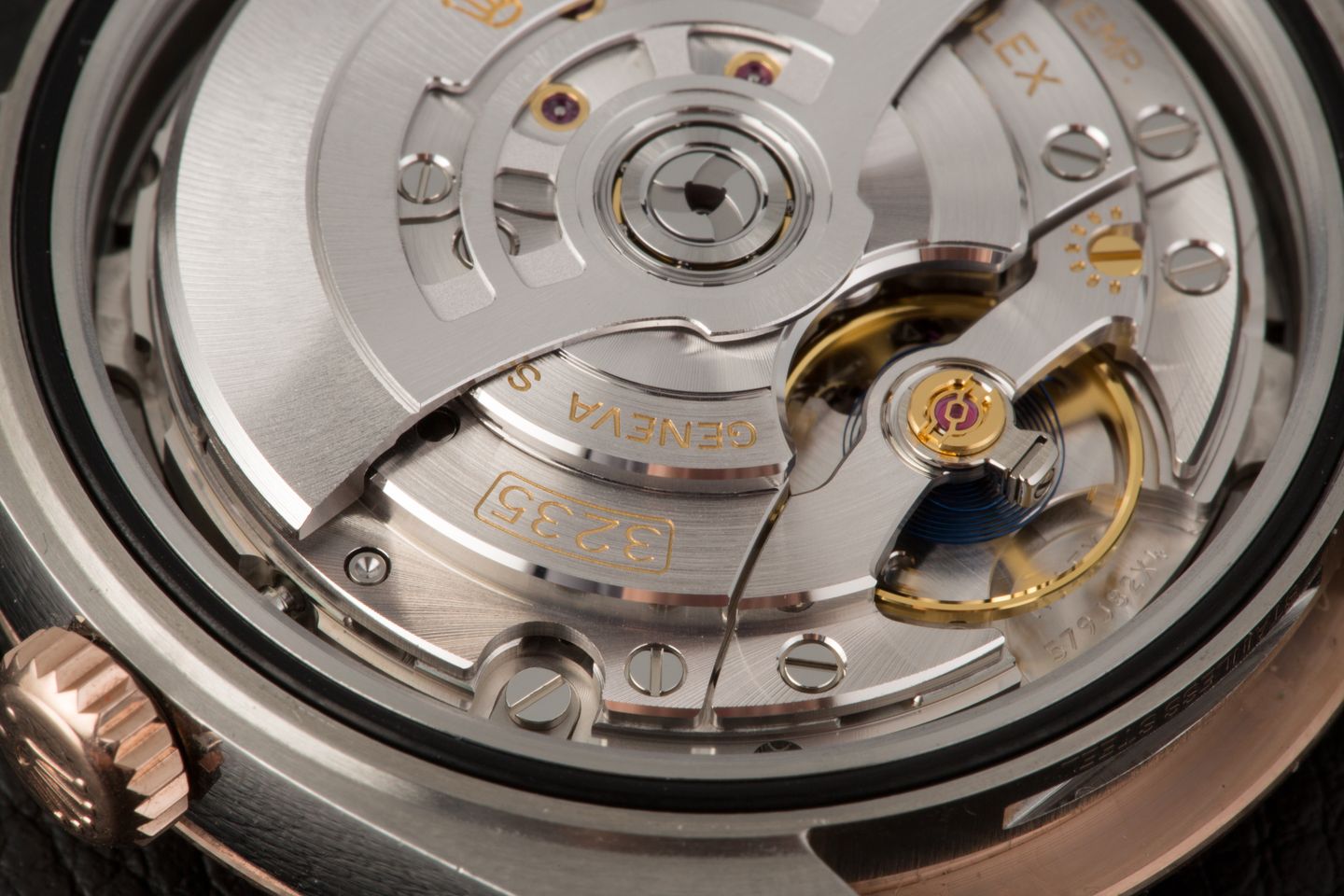
Rolex Movements
The movement (also known as the caliber) is the beating heart of the watch. At its most basic, it controls the model’s main hands, but can also be constructed with various complications. A complication is any function above and beyond regulating the hour, minute, and seconds hands, and it can be something as simple as a date display up to (in Rolex’s case) the Sky-Dweller’s annual calendar or the Yacht-Master II’s adjustable regatta timer – the two most complex pieces in the brand’s modern collection.
Rolex’s movements are all developed and manufactured entirely in-house, and they have long been personified by their form-following-function composition. Rolex movements are made to keep working reliably, pretty much forever, just as long as they receive standard, regular maintenance. They are extremely robust and relatively simple, using the fewest parts possible, as the fewer components there are, the less there is to go wrong.
Likewise, where other high-end manufacturers produce calibers with beautifully intricate decoration, Rolex’s finishing is more straightforward and industrial. There are also no watches in the present lineup with clear display case-backs as you will find among other brands, which let you see the movement in action.
The majority of the calibers Rolex currently uses fall within the Cal. 32xx series. First introduced in 2015, the constantly expanding range has been slowly taking over from the previous Cal. 31xx movements since then. There are now Cal. 32xx calibers in just about every time-only, time-and-date, GMT, and double calendar Rolex watch, with the different complications given to each variant resulting in the movement having a new caliber number.
Additionally, every Cal. 32xx movement benefits from the brand’s Chronergy escapement, which gives a 15% increase in efficiency over older versions, as well as the proprietary blue Parachrom hairspring. However, there are also a handful of more specialized movements, built entirely from the ground-up and issued as standalone mechanisms in their own right. Below we give a rundown of each one.
– Cal. 3230: The Caliber 3230 is the simplest, time-only movement Rolex now uses. You will find it in models such as the 36mm and 41mm Oyster Perpetual models, along with the no-date Submariner and the updated Rolex Explorer with a 36mm case diameter.
– Cal. 3235: The most widely-used movement in the catalog, the Caliber 3235 is Rolex’s time-and-date engine, powering the enormous range of 41mm and 36mm Datejust watches, the Submariner Date, the Sea-Dweller, the Deepsea, the Pearlmaster, and the Yacht-Master.
– Cal. 3255: The first of the new generation Cal. 32xx series to be brought out, the Caliber 3255 is the movement that drives the flagship Day-Date with its twin calendar complications.
– Cal. 3285: The Caliber 3285 is the latest Rolex GMT-equipped caliber, designed to track a second time zone. It is found inside the GMT-Master II series and the current Explorer II watches.
*At the time of writing, Rolex is in the process of replacing all of the former Cal. 31xx range and there are several models still using the older movements. These are likely to be superseded very soon, but for now, those calibers are listed below.
– Cal. 3132: Only used in the Rolex Cellini Time, the Caliber 3132 is another time-only movement, fitted with Paraflex shock absorbers and a blue Parachrom hairspring.
– Cal. 3131: A movement shared by both the Air-King and the Milgauss, the Cal. 3131 has enhanced antimagnetic abilities, working in conjunction with the watches’ magnetic shield to provide protection from fields in excess of 1,000 gauss.
– Cal. 3165: Found in the Cellini Date, the Caliber 3165 powers the watch’s large, date displaying sub-dial.
– Cal. 3180: The Caliber 3180 is the GMT-equipped movement found inside the Cellini Dual Time.
– Cal. 3195: The Caliber 3195 drives the Cellini Moonphase and offers the watch’s namesake lunar complication.
Specialty Movements
– Cal. 4130: The first chronograph caliber Rolex ever built entirely in-house, the Caliber 4130 drives the Cosmograph Daytona. Recognized as one of the finest of its type currently in production, the column wheel-controlled movement features a vertical clutch for superior performance.
– Cal. 4161: Originally based on the Daytona’s movement above, the Caliber 4161 powers the extremely complicated Yacht-Master II. Devised to help skippers time the convoluted starting procedures of yacht races, it includes the world’s first-ever programmable flyback (and fly-forward) regatta timer with a mechanical memory.
– Cal. 9001: With 380 separate components, the Caliber 9001 is Rolex’s most complex movement to date. It fits inside the Sky-Dweller, the brand’s top-of-the-range traveler’s watch, and packs in a date, GMT function, and an annual calendar complication. An annual calendar is one that compensates for the different number of days in each month, meaning that it only needs to be manually adjusted once a year, on the 1st March.
Smaller Rolex Movements
The movements inside Rolex’s selection of midsize and ladies’ watches are, if anything, even more impressive than their larger counterparts. Held to the same exacting standards, they have to do it all with smaller components and often tighter tolerances. The newly introduced Cal. 22xx series all benefit from Syloxi hairsprings.
– Cal. 2232: Released in 2020, this simple time-only movement powers the 28mm, 31mm, and 34mm Oyster Perpetual models.
– Cal. 2236: The date-displaying version of the Cal. 2232, this caliber is found in the 28mm and 31mm Datejust watches.
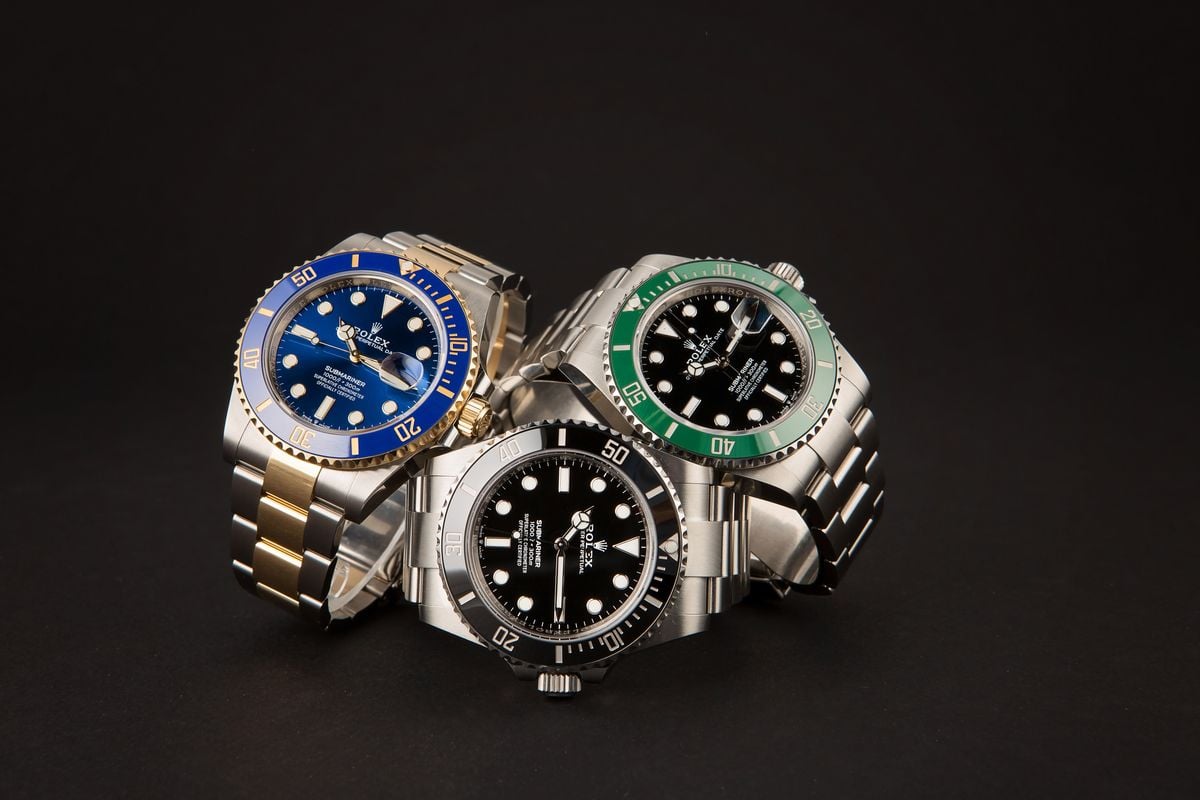
The Current Rolex Collection Watches
So far, we have looked at Rolex history, movements, terms, bezels, and bracelets. Now it is time to explore the watches themselves.
As we said at the beginning, Rolex itself uses two categories: the Professional Collection, which is home to the brand’s various sport and tool models; and the Classic Collection that contains everything else, including both casual and formal dress watches. However, many Rolex watches can easily do double duty as both casual and formal wear, so there is no need to feel restricted in your choice. For example, you will find plenty of Rolex dive watches paired with suits around boardroom tables.
Below, is the entire catalog of Rolex watches:
Professional Collection Rolex Watches
Rolex classifies its “Professional” models as those that are purpose-built for a specific use, such as sports, active environments, or lifestyle activities.
Rolex Submariner
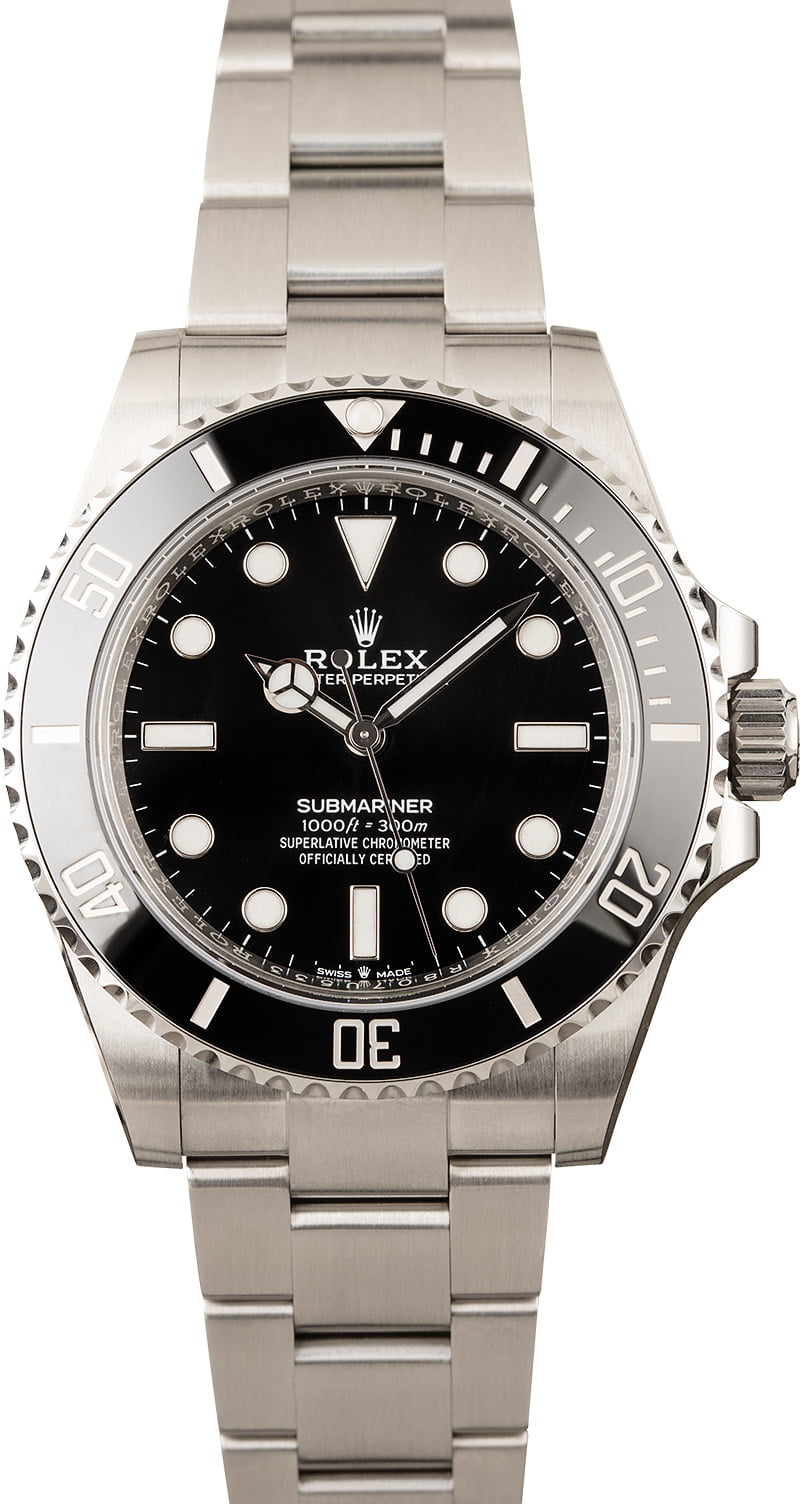
Submariner Key Features:
– Case Size: 41mm
– Materials: Oystersteel; White gold; Yellow gold; Yellow Rolesor
– Features: Time-only; Time + Date display
– Dial: Black; Blue
– Bezel: Unidirectional w/ 60-minute dive scale. Cerachrom insert in Black; Blue; Green
– Movement: Cal. 3230 (no-date); Cal. 3235 (date)
– Water Resistance: 300 meters / 1,000 feet
– Bracelet: Oyster bracelet w/ Oysterlock Clasp and Glidelock Extension
Click here for our Ultimate Buying Guide on the Rolex Submariner.
The most iconic dive watch ever made and one of the most important sports models of all time, the Submariner needs little introduction. Debuting in 1953, the Rolex Submariner was the first of its type to be water-resistant to 100m. Over the years, its rating has tripled, precious metal versions have been launched, and a date function has been added.
Today, there are eight versions to choose from, with metal options including stainless steel, Yellow Rolesor, solid white gold, and solid yellow gold. Dial options include either blue or black, and bezels can be either black, blue, or green. Additionally, the one no-date model, in stainless steel and with a black dial and bezel, offers perhaps the closest you can get to the original essence of the Submariner – the no-nonsense, tough yet impossibly stylish watch with timeless looks.
Often the first port of call for any new collector, the Rolex Submariner is versatile enough to be worn with practically anything, and it effortlessly fills the role of being the only watch you will ever need.
Rolex Sea-Dweller
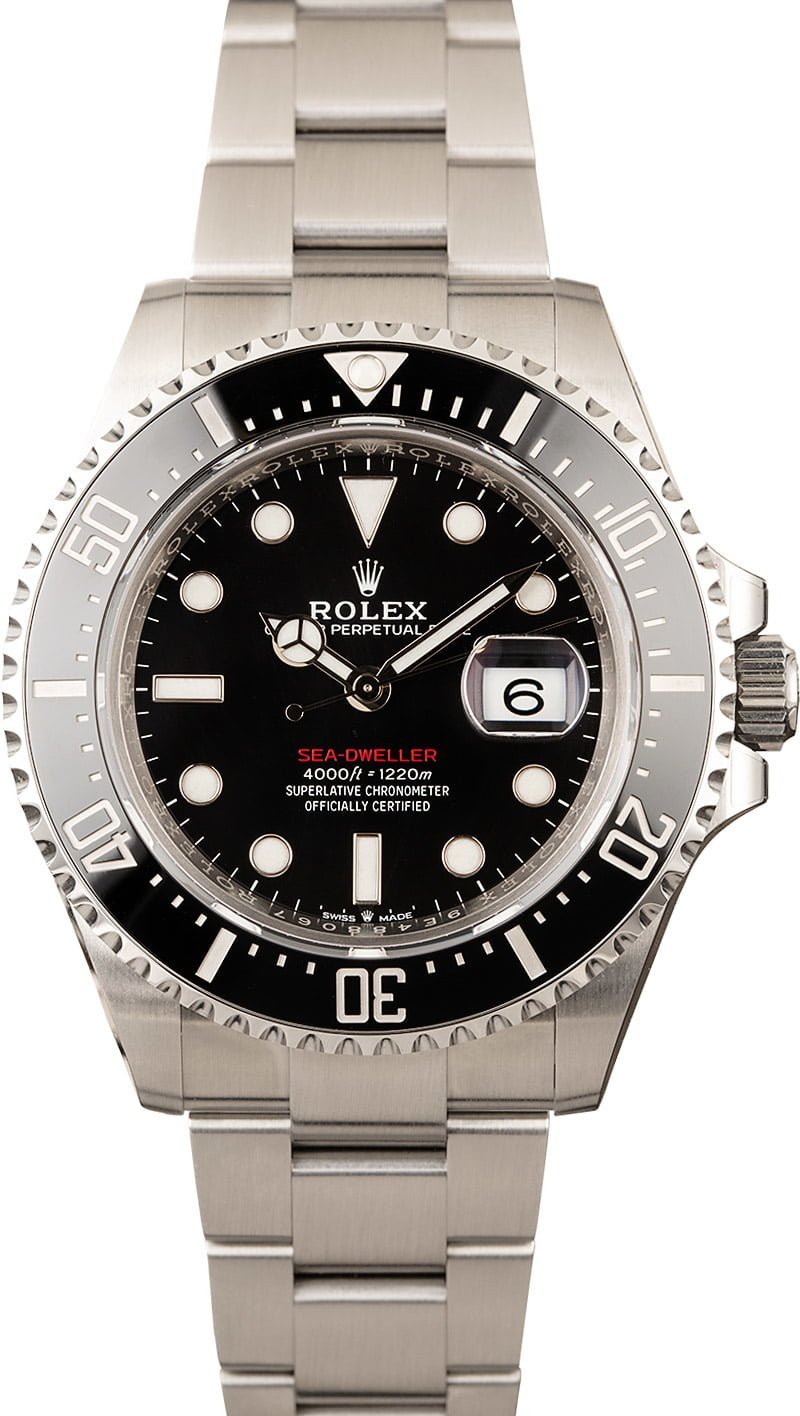
Sea-Dweller Key Features:
– Case Size: 43mm
– Materials: Oystersteel; Yellow Rolesor
– Features: Time + Date display
– Dial: Black
– Bezel: Unidirectional w/ 60-minute dive scale. Black Cerachrom insert
– Movement: Cal 3235
– Water Resistance: 1,220 meters / 4,000 feet (Helium Escape Valve)
– Bracelet: Oyster bracelet w/ Oysterlock Clasp and Glidelock + Fliplock Extension Systems
Click here for our Ultimate Buying Guide on the Rolex Sea-Dweller.
The Submariner’s bigger brother got even bigger a few years ago when it emerged in a new 43mm case, discarding its time-honored 40mm dimensions. First appearing in 1967, it was initially designed for the world of saturation diving and debuted the industry’s first Helium Escape Valve (HEV), a small regulator in the side of the case that lets the watch decompress at the same time as the diver wearing it.
The Rolex Sea-Dweller stuck rigidly to its tool watch roots for decades, appearing only in all-steel guises. However, Rolex shook things up considerably in 2019, when it gave the Sea-Dweller a two-tone Yellow Rolesor version, marking the first time that precious metals had ever been featured on a Sea-Dweller watch.
Extremely robust and waterproof to an incredible 4,000ft, the Rolex Sea-Dweller is a watch that will never be pushed past its limits.
Rolex Deepsea Sea-Dweller
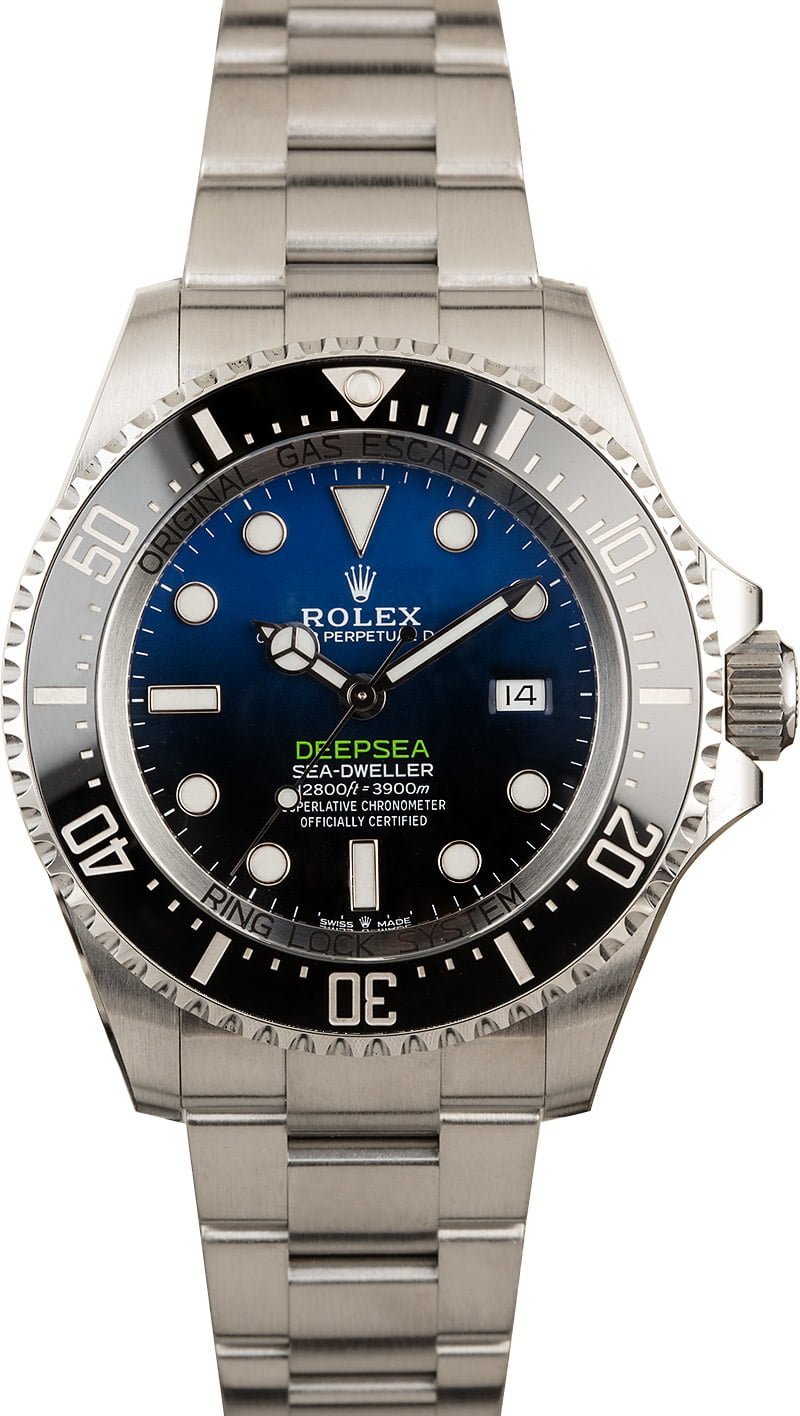
Deepsea Key Features:
– Case Size: 44mm
– Materials: Oystersteel
– Features: Time + Date display
– Dial: Black; D-Blue
– Bezel: Unidirectional w/ 60-minute dive scale. Black Cerachrom insert
– Movement: Cal 3235
– Water Resistance: 3,900 meters / 12,800 feet (Helium Escape Valve + Ring Lock System)
– Bracelet: Oyster bracelet w/ Oysterlock Clasp and Glidelock + Fliplock Extension Systems
Click here to discover the difference between the Sea-Dweller and the Rolex Deepsea.
The third of Rolex’s underwater trio, and the largest watch in the brand’s collection, the Rolex Deepsea is a dive watch turned up to 11. A combination of some extreme engineering, a couple of space-age alloys, and a sapphire crystal more than 5mm thick means the Deepsea can survive a plunge to roughly two-and-a-half miles beneath the waves.
The Ring Lock system redistributes the skull-crushing pressures evenly around the watch’s surface area and the titanium case-back is allowed to flex slightly to soak up the stresses. Available with either a black dial or Rolex’s only split color face, the D-Blue dial, launched to commemorate James Cameron’s record-breaking descent to the deepest parts of the world’s oceans in the Mariana Trench.
A huge watch with capabilities as enormous as its wrist presence, the Rolex Deepsea Sea-Dweller always gets noticed and can travel down deeper than the ocean itself.
Rolex Daytona
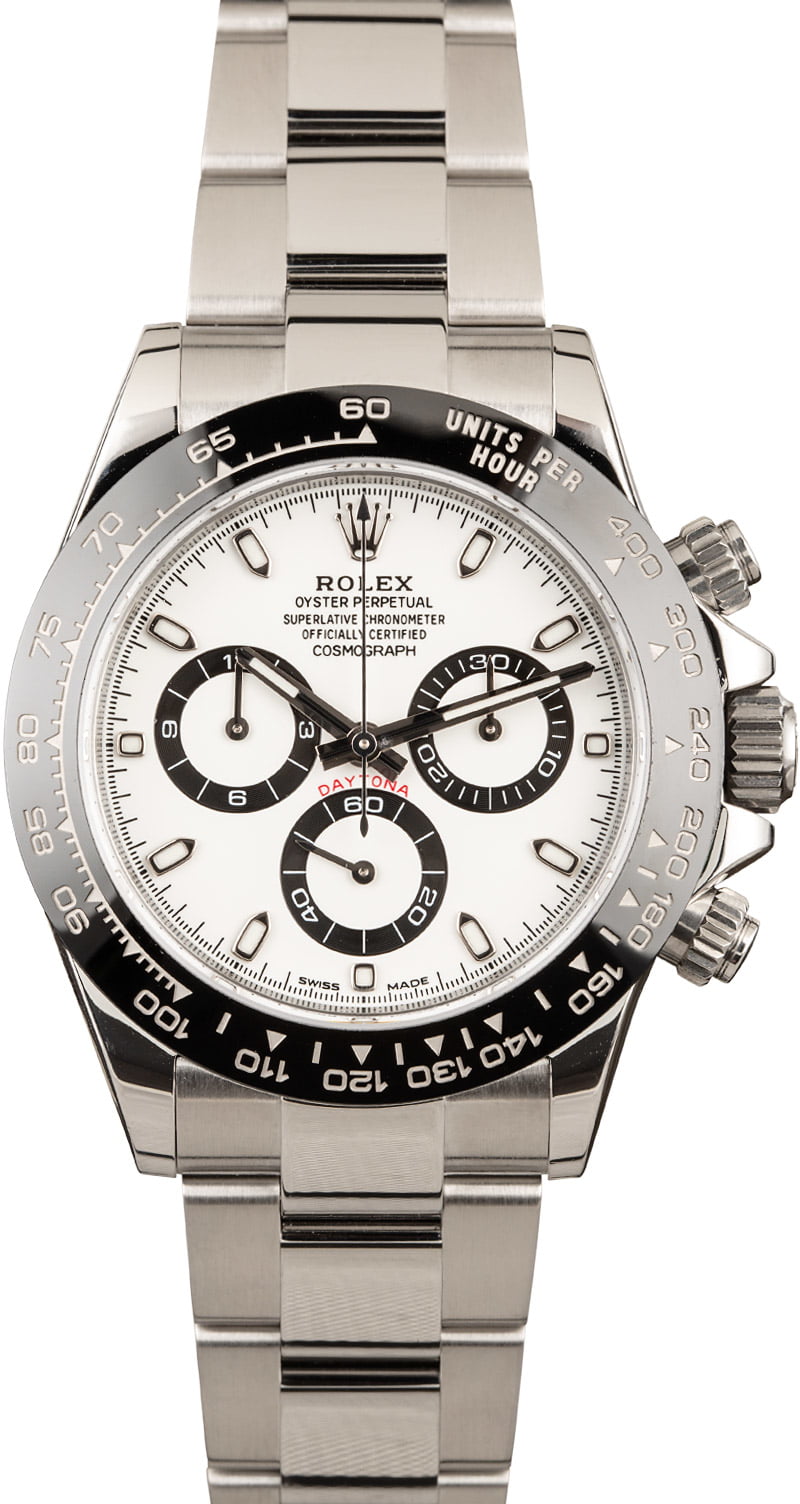
Cosmograph Daytona Key Features:
– Case Size: 40mm
– Materials: Oystersteel; White gold; Everose gold; Yellow gold; Yellow Rolesor; Platinum
– Features: Time w/ running seconds + 12-hour chronograph
– Dial: Numerous colors; Mother of pearl; Gem-set
– Bezel: Fixed w/ tachymeter scale. Crafted from Cerachrom; Gold; Platinum
– Movement: Cal 4130
– Water Resistance: 100 meters / 330 feet
– Bracelet: Oyster bracelet or Oysterflex bracelet w/ Oysterlock Clasp and Easylink Extension
Click here for our Ultimate Buying Guide on the Rolex Daytona.
Arguably the world’s most famous chronograph, the Rolex Cosmograph Daytona debuted in 1963. Today it has the most varied lineup of any watch in Rolex’s Professional Collection, forged in just about every metal the brand offers, including the ultimate shimmering luxury of platinum, and with enough dial options to suit anyone’s taste.
Far from being all show, however, the Rolex Daytona is one of the most proficient mechanical stopwatches on the market, with an impeccable engine that is able to time events down to 1/8th of a second with seamless start and stop operations due to its use of a column-wheel chronograph and vertical clutch.
Talented, handsome, and massively sought-after, the Rolex Daytona is a true legend, both in the world of racing and beyond.
Rolex GMT-Master II
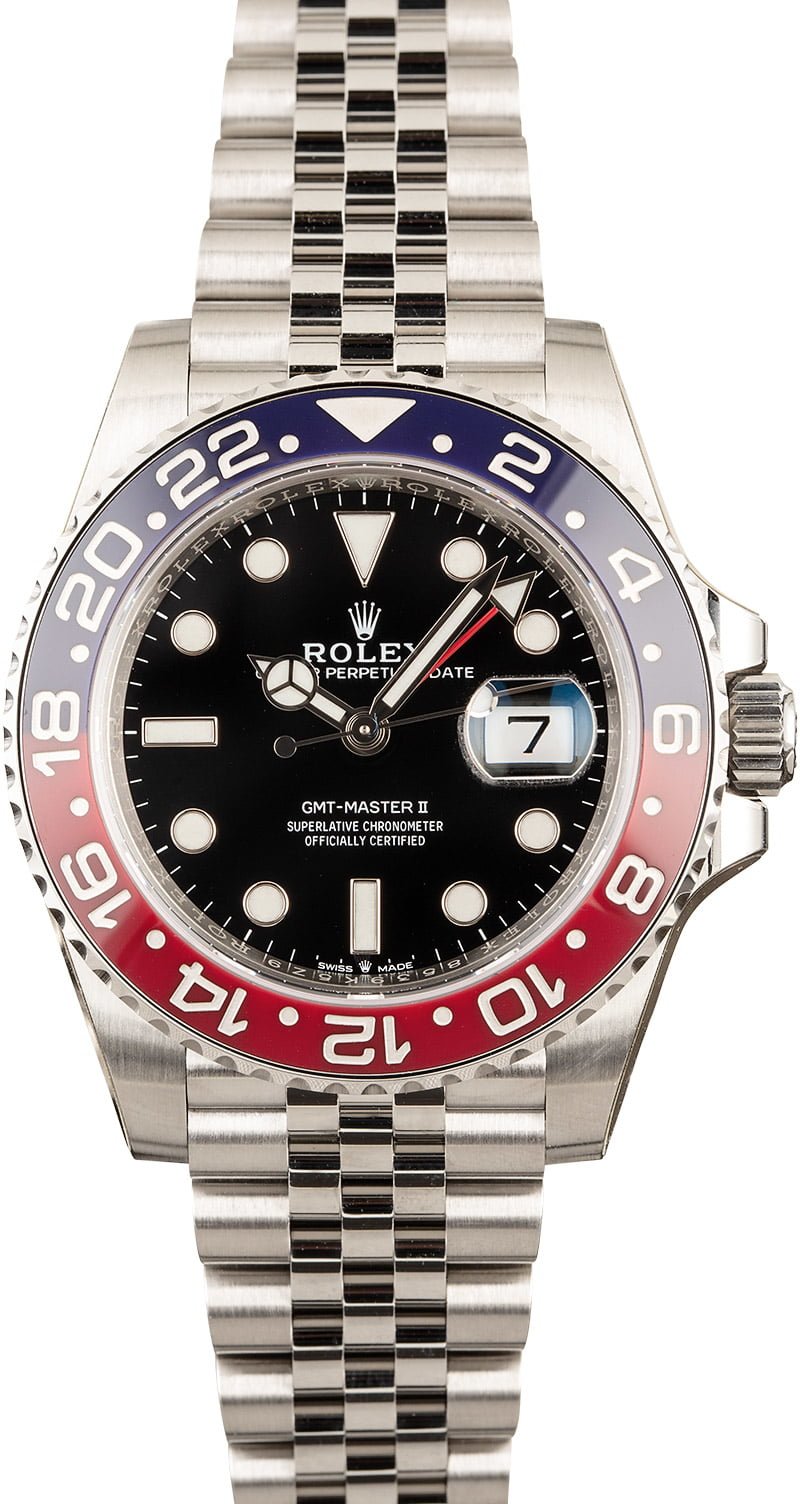
GMT-Master II Key Features:
– Case Size: 40mm
– Materials: Oystersteel; White gold; Everose gold; Everose Rolesor
– Features: Time + Date display w/ GMT functionality
– Dial: Black; Blue; Meteorite
– Bezel: Bidirectional w/ 24-hour scale. Cerachrom insert in Blue/Black (Batman); Blue/Red (Pepsi); Black/Brown (Root Beer)
– Movement: Cal 3285
– Water Resistance: 100 meters / 330 feet
– Bracelet: Oyster bracelet or Jubilee bracelet w/ Oysterlock Clasp and Easylink Extension
Click here for our Ultimate Buying Guide on the Rolex GMT-Master.
What the Rolex Submariner is to dive watches, the Rolex GMT-Master II is to travel watches. An undeniable icon of both the brand and the horology industry in general, the original GMT-Master was built to help Pan Am Airlines crews fight off the effects of jet lag. By outfitting the watch with a second hour hand and rotating 24-hour bezel, wearers were able to keep tabs on two time zones simultaneously.
The arrival of the GMT-Master II, which allowed for the pair of hour hands to be set independently of each other, means that a third-time zone can be tracked with the bezel. However, it will always be the watch’s various color schemes, which remain its defining characteristic. The blue and red ‘Pepsi’ bezel has always been with us, and the modern collection also includes the blue and black ‘Batman’ and the retro-inspired black and brown ‘Root Beer’ bezel.
A gem of a watch with a genuinely useful complication, the Rolex GMT-Master II is a must-have for both frequent travels and watch enthusiasts.
Rolex Yacht-Master
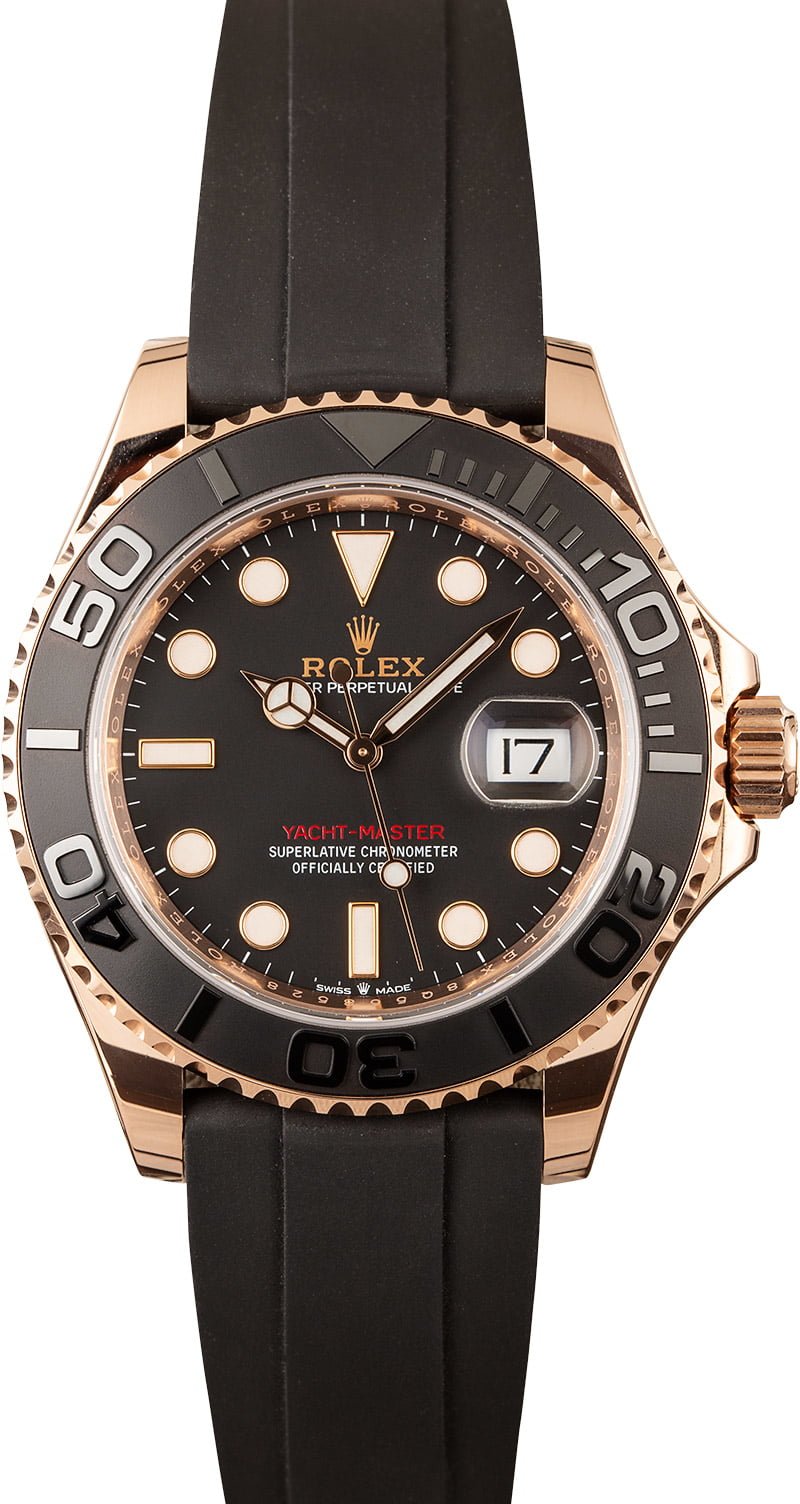
Yacht-Master Key Features:
– Case Size: 37mm; 40mm; 42mm
– Materials: White gold; Everose gold; Rolesium; Everose Rolesor
– Features: Time + Date display
– Dial: Black; Dark Rhodium; Chocolate; Blue; Gem-set
– Bezel: Bidirectional w/ 60-minute timing scale. Bezel insert in Cerachrom; Gold; Platinum
– Movement: Cal. 2236; Cal. 3235
– Water Resistance: 100 meters / 330 feet
– Bracelet: Oyster bracelet or Oysterflex bracelet w/ Oysterlock Clasp and Glidelock Extension
Click here for our Ultimate Buying Guide on the Rolex Yacht-Master.
The Rolex Yacht-Master was introduced in 1992 as a more luxurious take on the Submariner. As such, while the two models definitely share the same underpinnings, the Yacht-Master has an altogether softer look and a collection with far more precious metal versions than the ubiquitous dive watch.
Although it is a relatively young name in the Rolex canon, the Yacht-Master has notched up a number of firsts during its run. It was the first of the brand’s sports watches available in three sizes (originally 29mm, 35mm, 40mm), the first to be issued with a steel case and platinum bezel (known as Rolesium) and it was the model chosen to debut Rolex’s rubber strap, the Oysterflex bracelet.
These days, Rolesium is still an option, but the three sizes have shifted upwards, now 37mm, 40mm, and 42mm. The current collection is actually split down the middle, between metallic bezel pieces on Oyster bracelets and Cerachrom bezel models on the Oysterflex. Looking at them side by side, you could be forgiven for thinking they are from two completely different watch families, such is the impact a swap in bracelet and bezel can have. The all-metal models are a classic and unmistakably opulent series, whereas the ceramic range is cool and stylishly sporty.
A luxury-oriented alternative to the ever-present Submariner, the Rolex Yacht-Master is a fascinating watch with a range of options.
Rolex Yacht-Master II
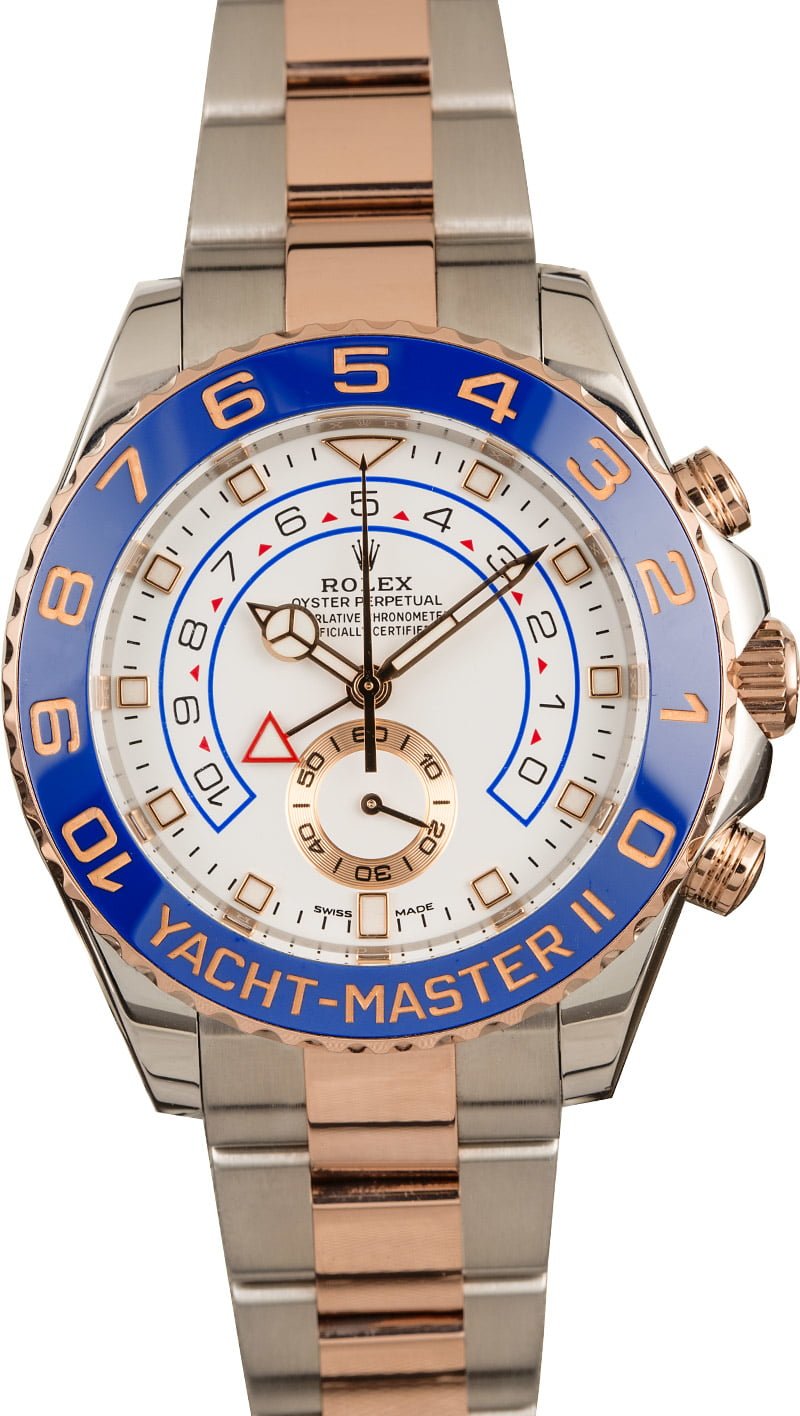
Yacht-Master II Key Features:
– Case Size: 44mm
– Materials: Oystersteel; Rolesium; Everose Rolesor; Yellow gold
– Features: Time w/ running seconds + Regatta timer
– Dial: White
– Bezel: Ring Command Bezel. Insert in Blue Cerachrom; Platinum
– Movement: Cal. 4161
– Water Resistance: 100 meters / 330 feet
– Bracelet: Oyster bracelet w/ Oysterlock Clasp and Easylink Extension
Click here for our Ultimate Buying Guide on the Rolex Yacht-Master II.
Possibly the most in-your-face design Rolex has ever unleashed, the Yacht-Master II is similar to its namesake in no way whatsoever. Whereas the original Yacht-Master is a simple time-and-date model inside a restrained and almost austere shell, the Yacht-Master II is an extremely complex watch with a brash extroverted exterior.
It measures the same 44mm diameter as the hulking Deepsea but does, even more, to get noticed with its eccentric dial layout and (on most versions) its bright blue ceramic bezel. However, this being Rolex, it all serves a purpose. The Yacht-Master II is the first watch to offer a programmable countdown timer with mechanical memory, built specifically for the world of professional yacht racing to help skippers accurately time the starts of races.
While it’s not one for the brand’s wallflowers, there’s no denying the brilliance of the engineering behind the Rolex Yacht-Master II, particularly from a brand not known for its complicated watches.
Rolex Explorer
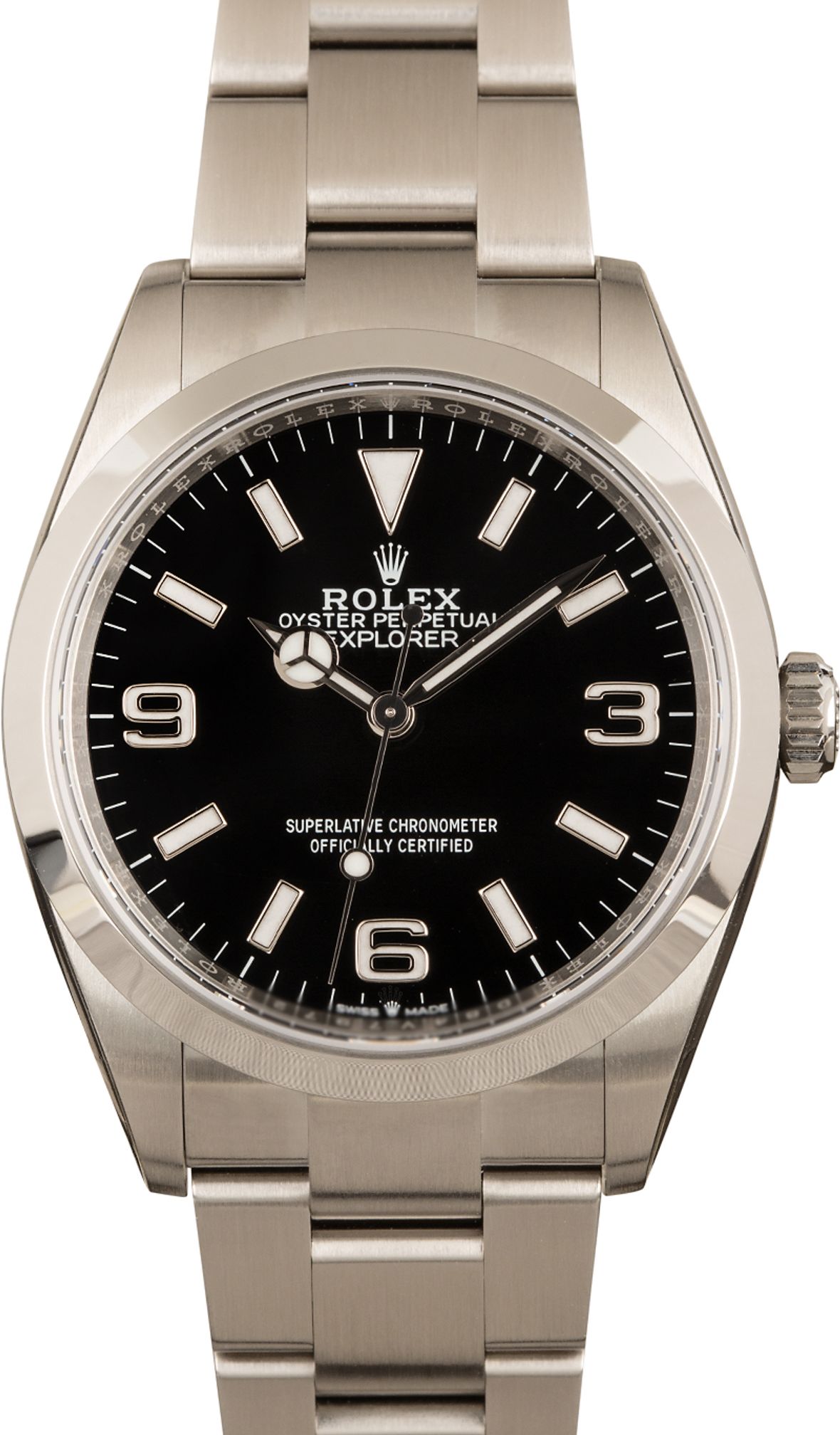
Explorer Key Features:
– Case Size: 36mm
– Materials: Oystersteel; Yellow Rolesor
– Features: Time-Only
– Dial: Black
– Bezel: Fixed. Smooth
– Movement: Cal. 3232
– Water Resistance: 100 meters / 330 feet
– Bracelet: Oyster bracelet w/ Oysterlock Clasp and Easylink Extension
Click here for our Ultimate Buying Guide on the Rolex Explorer.
The Explorer is one of the oldest names on Rolex’s books and could arguably hold the title of the first modern tool watch. In constant production since 1953, it was created in recognition of the successful ascent of Everest that year by Hillary and Norgay. While it may not have anything to speak of in terms of extra functionality, it is easily one of the purest models in the collection – crafted only in stainless steel up until 2021 when a two-tone steel and gold model joined the lineup, its seminal dial with its 3/6/9 numerals is both highly readable and starkly beautiful – and only ever offered in black.
The current generation marked the return of the Explorer’s historic and highly versatile 36mm case size, which represents one of the very few times in Rolex’s history that it has actually decreased the case size of one of its models. After spending around a decade at 39mm, the Rolex Explorer returned to the same 36mm case diameter as the inaugural model from 1953. Additionally, a Yellow Rolesor model in stainless steel and 18k yellow gold joined the collection in 2021, marking the first time in the Explorer’s history that it was ever manufactured in anything other than stainless steel.
Among a sea of solid gold dive models and platinum chronographs, the Rolex Explorer remains a tool watch in the truest sense of the word.
Rolex Explorer II
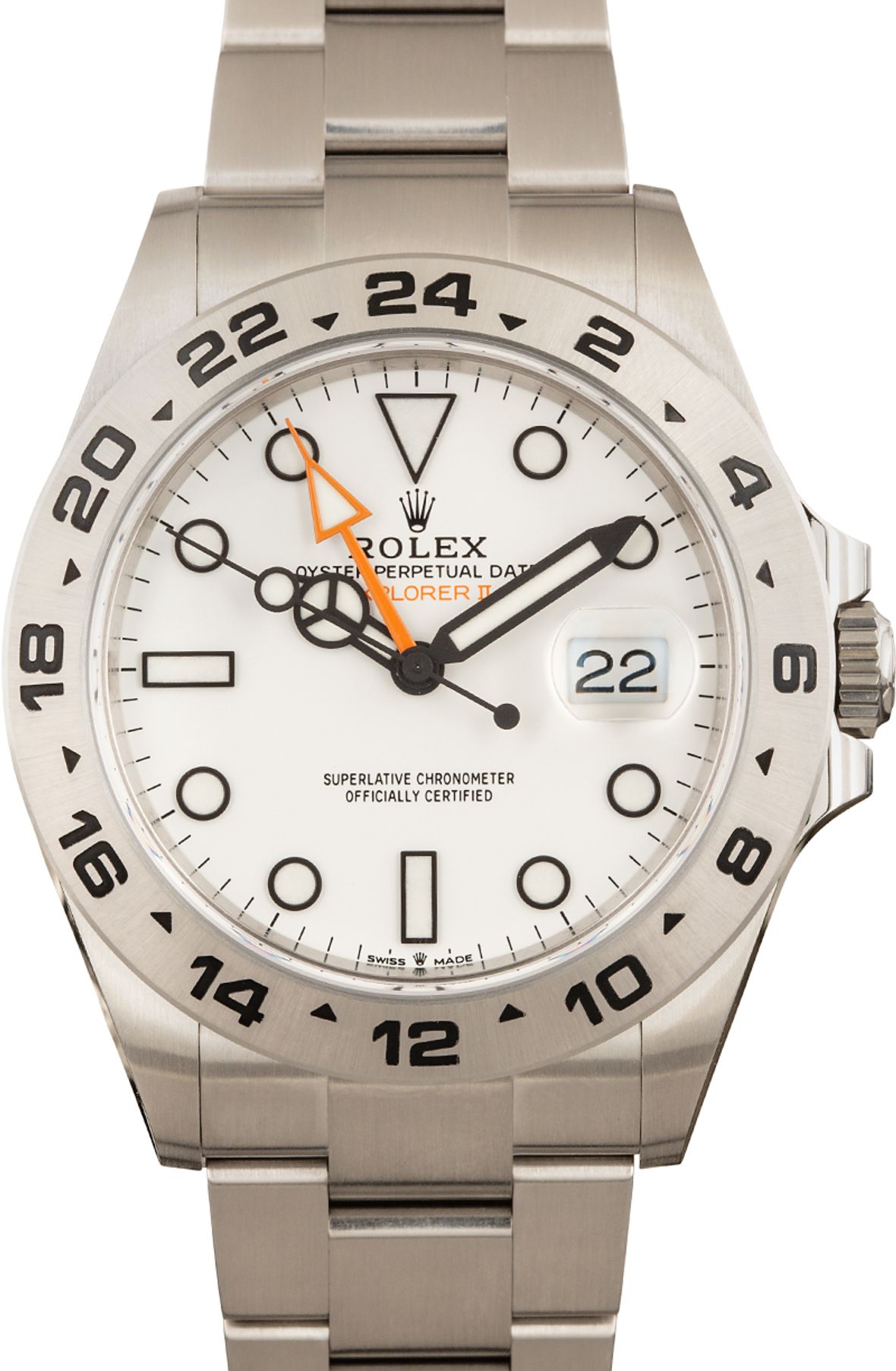
Explorer II Key Features:
– Case Size: 42mm
– Materials: Oystersteel
– Features: Time + Date display w/ GMT functionality
– Dial: Black; White
– Bezel: Fixed 24-hour scale. Stainless steel
– Movement: Cal. 3285
– Water Resistance: 100 meters / 330 feet
– Bracelet: Oyster bracelet w/ Oysterlock Clasp and Easylink Extension
Click here for our Ultimate Buying Guide on the Rolex Explorer II.
Like the Yacht-Master versus the Yacht-Master II, the original Explorer shares very few similarities with its sequel. Debuting in 1971, the Explorer II was built for spelunkers (cave explorers). Spending long periods of time underground with no natural light, losing track of night and day is practically guaranteed. So, borrowing a page out of the GMT-Master’s book, the Explorer II was given a second hour hand and a 24-hour scale on its bezel to help wearers keep track of AM and PM hours.
While it never attracted the same level of devotion as the brands’ famed pilots watch, it is seen as something of a cult classic – and a good-looking, capable one at that. As with its older brother, the Explorer II has only ever been forged in stainless steel, but it does have the choice of either a black or white (known as Polar) dial, and its trademark bright orange extra hour hand lends a welcome pop of color.
Despite the fact that Rolex released an all-new Explorer II watch in 2021, the updated generation is largely the same as its predecessor. Along with slightly updated proportions and some minor aesthetic revisions to the dial and hands, the most significant update to accompany the new Rolex Explorer II ref. 226570 is the new-generation Caliber 3285 movement that it shares with the current GMT-Master II collection.
As one of the last Rolex sports watches to only ever be crafted from stainless steel, the Explorer II is the perfect embodiment of the peak of Rolex’s specialized tool-watch era.
Rolex Milgauss
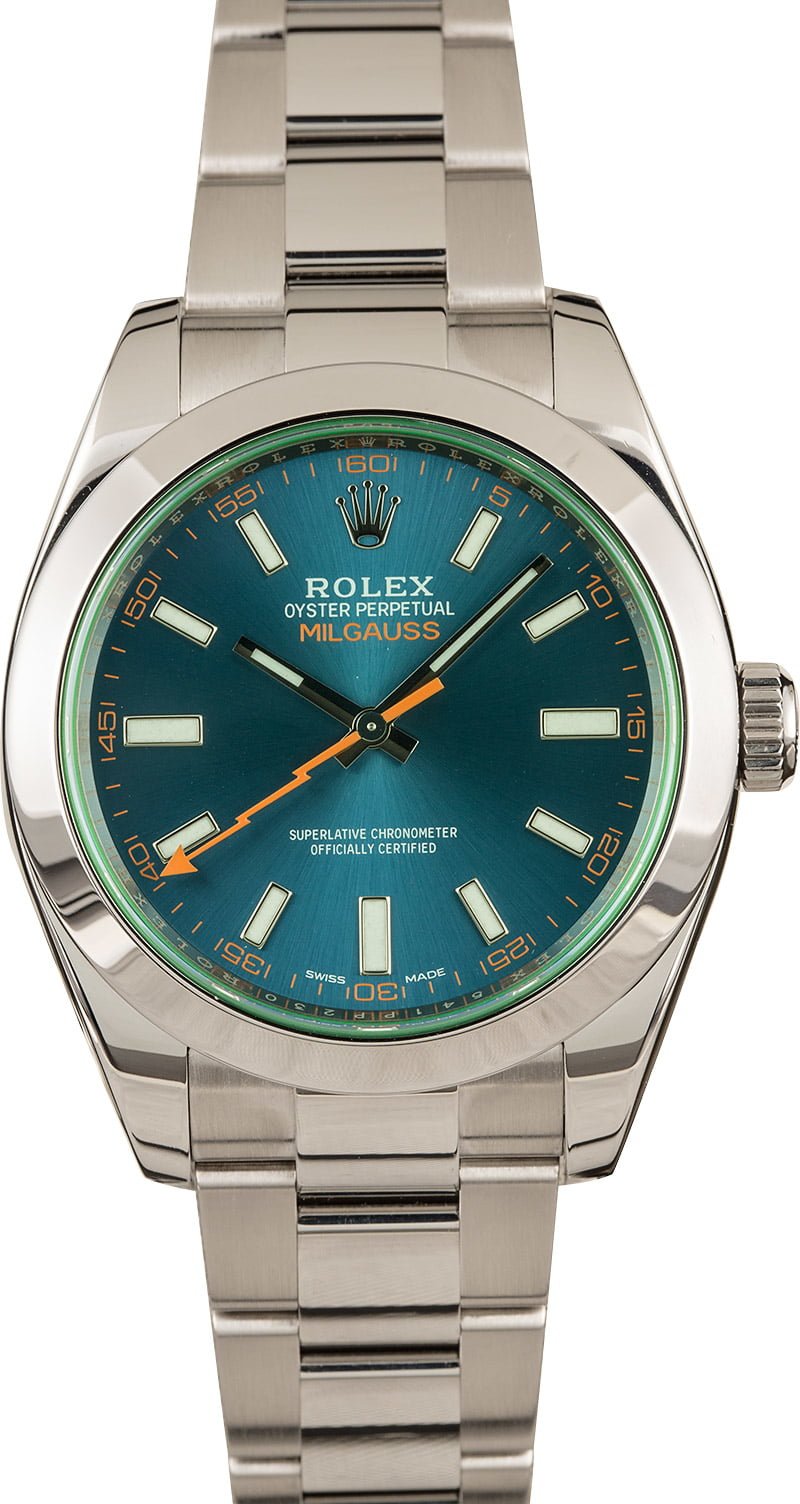
Milgauss Key Features:
– Case Size: 40mm
– Materials: Oystersteel
– Features: Time-Only
– Dial: Black; Z-Blue
– Bezel: Fixed. Smooth
– Movement: Cal. 3131
– Water Resistance: 100 meters / 330 feet
– Bracelet: Oyster bracelet w/ Oysterlock Clasp and Easylink Extension
Click here for our Ultimate Buying Guide on the Rolex Milgauss.
The Rolex Milgauss was brought out in 1956 as an answer to a never-before-experienced problem. With the introduction of new technologies, scientists and engineers were finding their watches being disrupted by the magnetic fields given off by state-of-the-art electrical equipment. With only a relatively weak force enough to affect a mechanical caliber, Rolex devised a way of protecting the Milgauss’s movement by shielding it inside a second, internal case that acted as a Faraday cage.
Although it offered defense against fields of up to 1,000 gauss (from where the watch got its name, with mille being the French for one thousand) the Milgauss was a slow seller and slips into the same sort of category as the Explorer II; cult favorite. These days, there are two versions available, with either a black dial or one in electric blue, called the Z-Blue. Both are covered with a unique green-tinted sapphire crystal (Glace Verte) and have an orange seconds hand shaped like a lightning bolt, as a nod to its electrifying past.
An often overlooked model and arguably one of the most visually distinct models in the brands’ current catalog, the Rolex Milgauss is both colorful and purpose-built.
Rolex Air-King
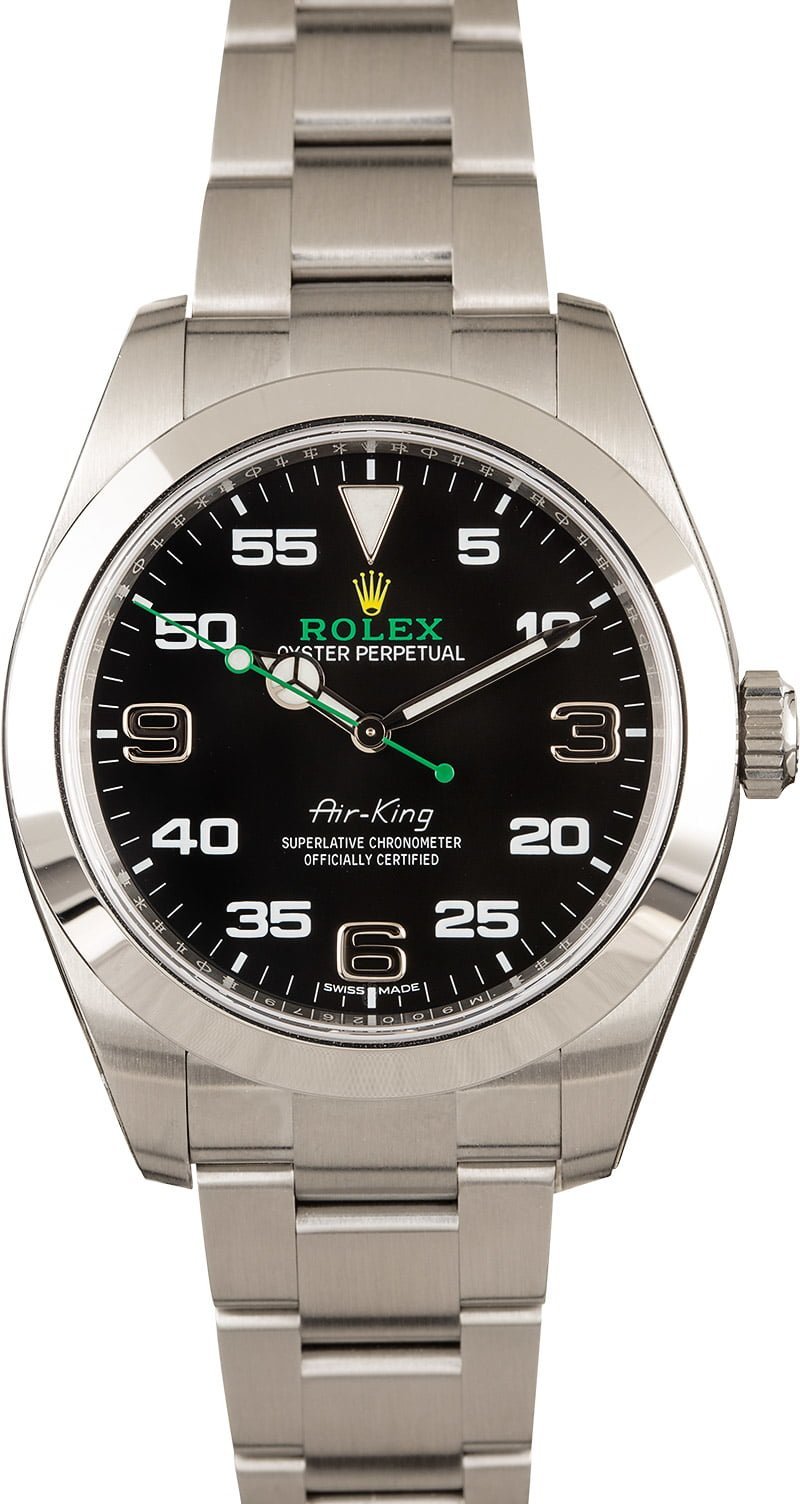
Air-King Key Features:
– Case Size: 40mm
– Materials: Oystersteel
– Features: Time-Only
– Dial: Black
– Bezel: Fixed. Smooth
– Movement: Cal. 3131
– Water Resistance: 100 meters / 330 feet
– Bracelet: Oyster bracelet w/ Oysterlock Clasp and Easylink Extension
Click here for our Ultimate Buying Guide on the Rolex Air-King.
Sharing a case, magnetic protection, and movement with the Milgauss, the Air-King is among the longest-serving watches Rolex offers. It started its journey during the Second World War, when brand founder, Hans Wilsdorf created a series of ‘Air’ watches to commemorate the heroics of England’s RAF during the Battle of Britain. The Air-King was the only model to continue in production, becoming its own collection in 1958. Today, it represents one of the most accessible watches in the lineup.
Devised for perfect legibility, the Rolex Air-King expands on the Explorer’s 3/6/9 dial and includes Arabic numerals at every five-minute mark. Available in black only, the seconds hand and the watch’s name are highlighted in green, while the Rolex coronet is in yellow, making it the only watch to have its dial script in three different colors.
As a gateway into the brand’s offerings, the Rolex Air-King offers tremendous value for the money, while still being truly unique in its overall aesthetic.
Classic Collection Rolex Watches
Rolex’s “Classic” watches are those that are not designed for a specific sport or lifestyle activity, but rather are intended to be worn every day and in a wide variety of different environments and settings.
Rolex Oyster Perpetual
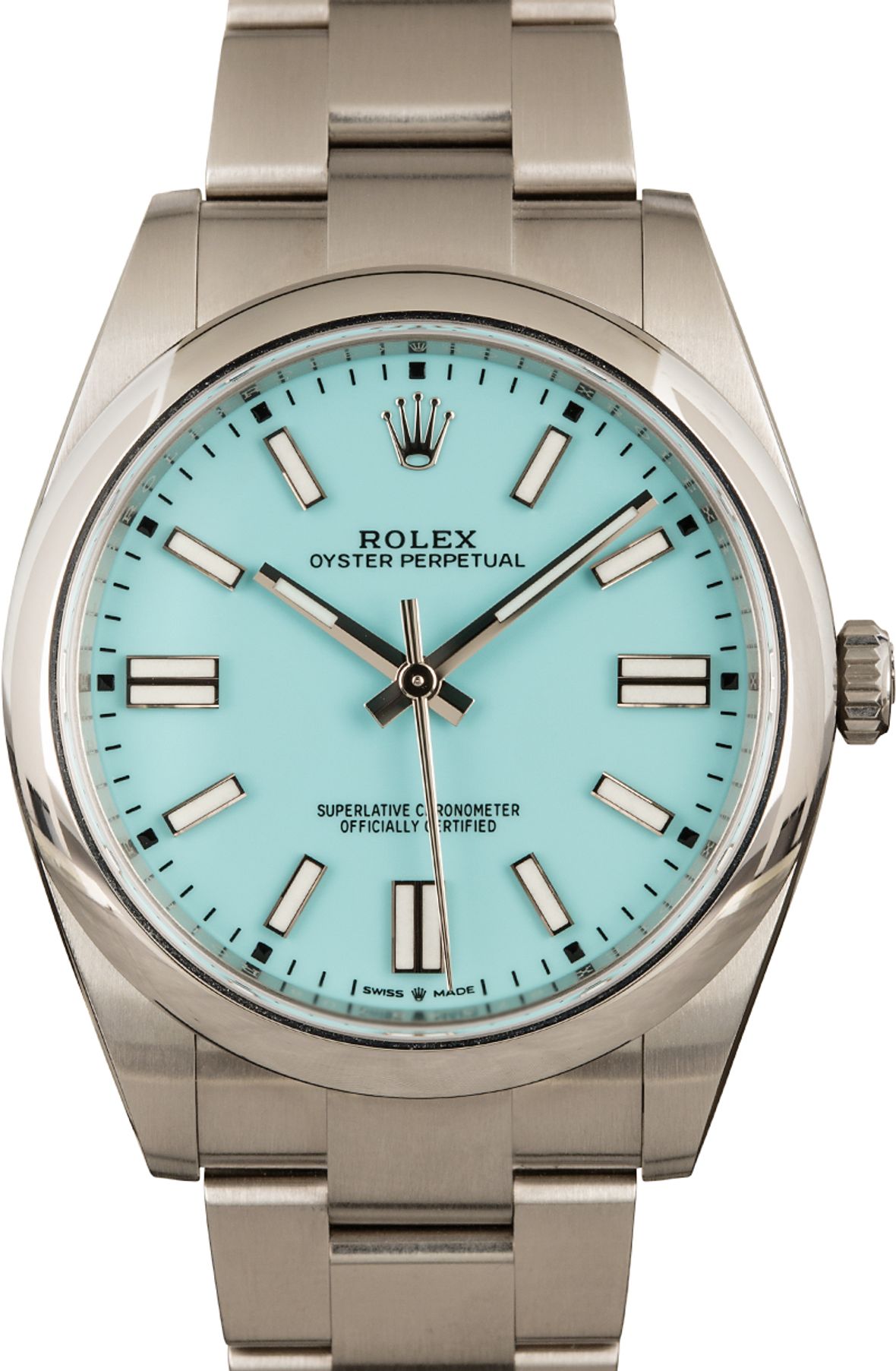
Oyster Perpetual Key Features:
– Case Size: 28mm; 31mm; 34mm; 36mm; 41mm
– Materials: Oystersteel
– Features: Time-Only
– Dial: Wide selection of colors
– Bezel: Fixed. Smooth
– Movement: Cal. 2232; Cal. 3230
– Water Resistance: 100 meters / 330 feet
– Bracelet: Oyster bracelet w/ Oysterclasp and Easylink Extension
Click here for our Ultimate Buying Guide on the Rolex Oyster Perpetual.
The Oyster Perpetual series is the simplest, most unfussy collection of watches in Rolex’s catalog. Like the Datejust, it is a unisex piece with the range covering five sizes although, as the least expensive of the brand’s models, all are made from Oystersteel.
Similarly, the only bezel choice is the smooth, domed type but the assortment of dial colors is extensive. Everything from monochrome black or white, right up to coral red and candy pink can be had, each with plain baton hour markers and stick hands. However, entry-level Rolex or not, the Oyster Perpetual still houses the latest crop of calibers across the board and the materials and quality of engineering are identical to models costing twice or three times as much.
A straightforward and occasionally lighthearted range of fine watches, the Rolex Oyster Perpetual makes the perfect opener to any luxury timepiece collection.
Rolex Datejust
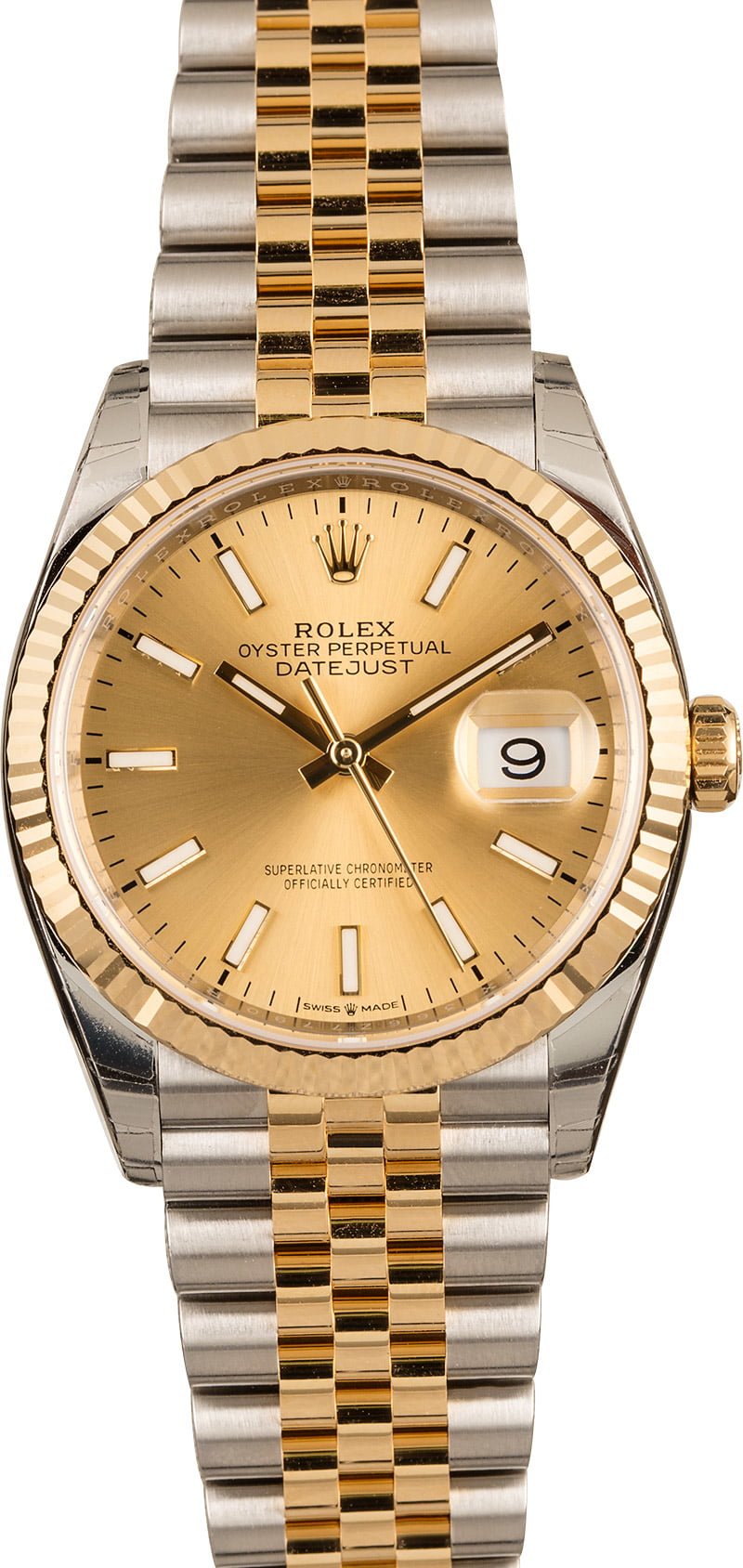
Datejust Key Features:
– Case Size: 28mm; 31mm; 34mm; 36mm; 41mm
– Materials: Oystersteel; Yellow gold; Everose gold; White gold; Yellow Rolesor; Everose Rolesor; White Rolesor
– Features: Time + Date display
– Dial: Wide selection of colors and styles; Gem-set
– Bezel: Fixed. Smooth; Fluted; Gem-Set
– Movement: Cal. 2236; Cal. 3135; Cal. 3235
– Water Resistance: 100 meters / 330 feet
– Bracelet: Oyster; Jubilee; President w/ Oysterclasp and Easylink Extension
Click here for our Ultimate Buying Guide on the Rolex Datejust.
It is hard to overstate the importance of the Rolex Datejust. Released in 1945, this was the watch that really put Rolex on the map, and it is the first waterproof, automatically winding model with a date function. It has consistently been the brand’s best-seller since its debut, and it is still just about the most chameleonic timepiece ever made.
Today, the range of different sizes, metal types, dials, bracelets, and bezels in which the Datejust is offered is staggering and designed to appeal to pretty much everybody, man or woman. It can be dressed up or down, go unnoticed or demand attention, and be the ideal companion for everything from a day at the beach to the swankiest cocktail party. But while the outside is as classically styled as a watch can be, the Datejust is still as contemporary as they come in terms of movements, with the whole range – except for the 34mm version (called simply The Date) – all now powered by the cutting-edge Cal. 22xx and Cal. 32xx series of movements.
The absolute epitome of the ‘one watch that can do it all’ the Rolex Datejust is just about the perfect everyday watch.
Rolex Day-Date
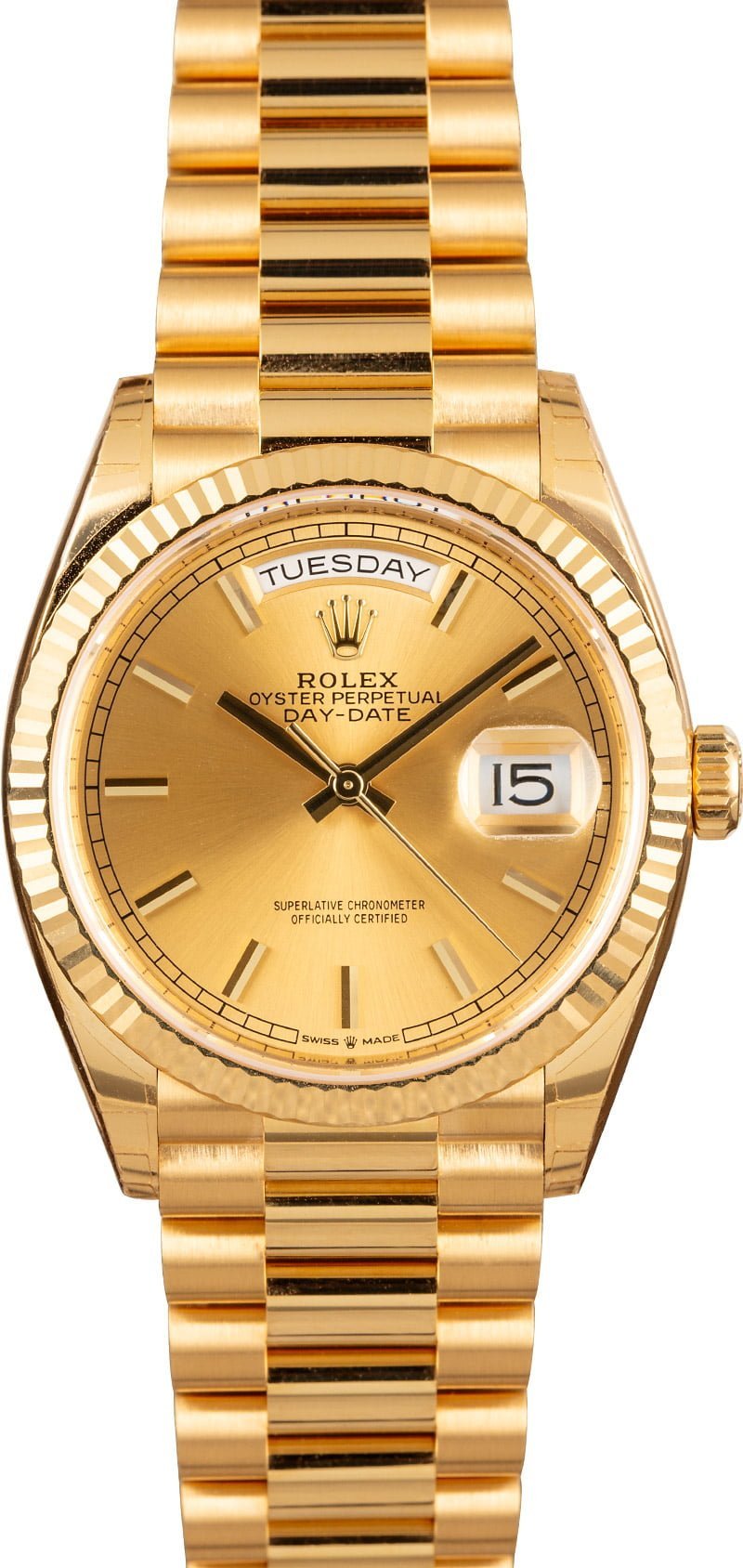
Day-Date Key Features:
– Case Size: 36mm; 40mm
– Materials: Yellow gold; Everose gold; White gold; Platinum
– Features: Time + Date display and Day complication
– Dial: Wide selection of colors and styles; Gem-set
– Bezel: Fixed. Smooth; Fluted; Gem-Set
– Movement: Cal. 3255
– Water Resistance: 100 meters / 330 feet
– Bracelet: President bracelets w/ Crownclasp
Click here for our Ultimate Buying Guide on the Rolex Day-Date.
The next logical step up from the Datejust, the Rolex Day-Date was released in 1956 and added a second calendar function, making it the first watch to also have the day of the week spelled out in full. It immediately took over flagship duties for Rolex’s entire portfolio, as an unashamedly elitist creation, worn by so many leaders of both companies and countries it soon picked up the nickname the President.
From the outset, the Day-Date has only ever been forged in the finest precious metals, with no hint of steel or even two-tone Rolesor making it into the lineup. The current collection has models in all three flavors of 18k gold, along with the noblest metal of all, platinum. Only a 36mm version was offered all the way up until 2008 when Rolex finally yielded to public opinion and released the short-lived Day-Date II in 41mm. That was replaced in 2015 by the Day-Date 40 (as in 40mm) and now the 36mm and 40mm sizes run alongside each other.
Like the Datejust, the possible dial, metal, bracelet, and bezel combinations here are huge, and there are plenty available showered in precious gemstones too. The President has now grown far beyond its conservative roots and is worn by the most successful people from all walks of life, from boardroom autocrats to hip hop moguls and movie stars to heavyweight champions.
One of the most aspirational timepieces in the world, the Rolex Day-Date is a powerful symbol of prestige.
Rolex Sky-Dweller
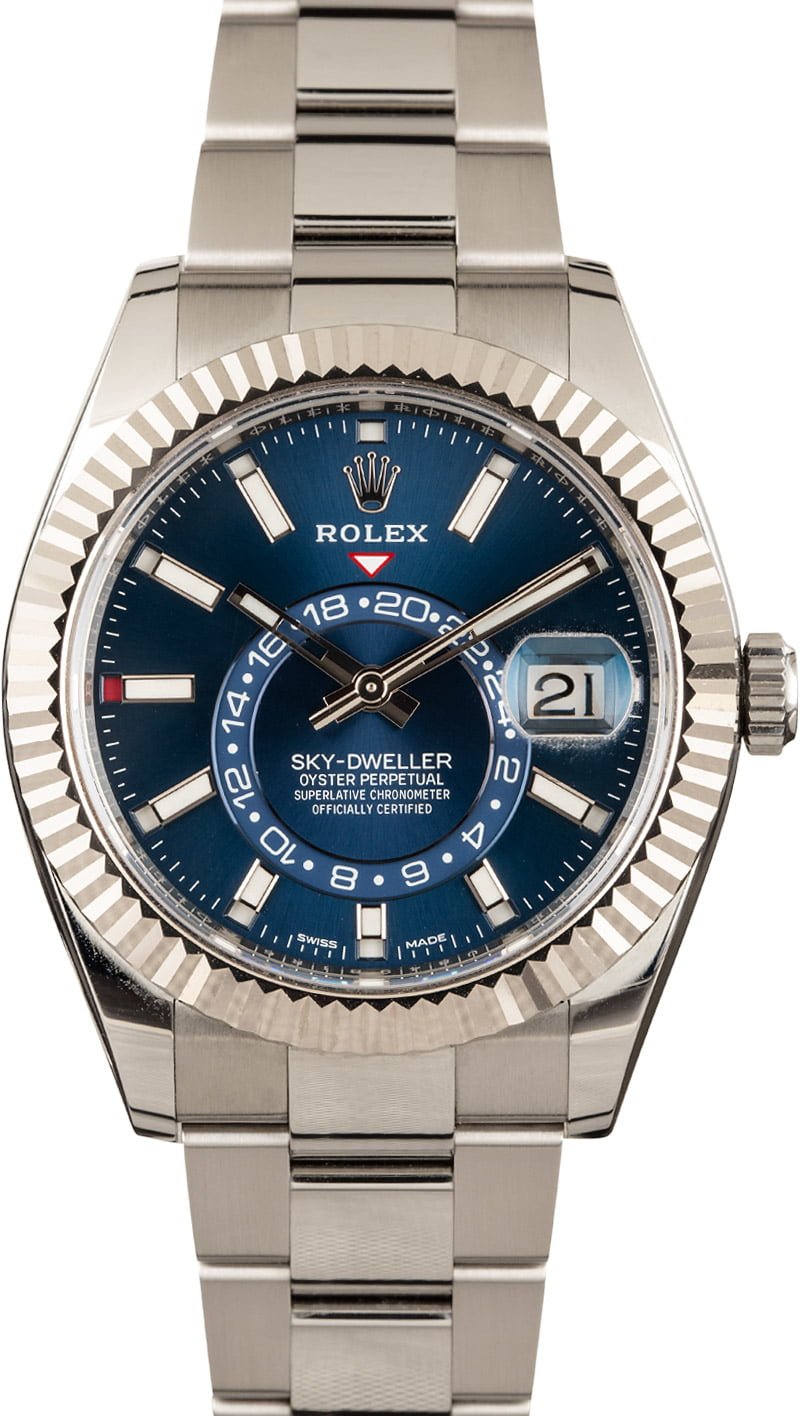
Sky-Dweller Key Features:
– Case Size: 42mm
– Materials: White Rolesor; Yellow Rolesor; Yellow gold; Everose gold
– Features: Time + Date display with Annual calendar and GMT functionality
– Dial: Black; White; Dark Rhodium; Champagne; Blue; Chocolate
– Bezel: Ring Command Bezel. Fluted
– Movement: Cal. 9001
– Water Resistance: 100 meters / 330 feet
– Bracelet: Oyster bracelet or Jubilee bracelet w/ Oysterclasp and Easylink Extension; Oysterflex bracelet w/ Oysterclasp and Glidelock Extension
Click here for our Ultimate Buying Guide on the Rolex Sky-Dweller.
The Sky-Dweller is Rolex’s top-drawer traveler’s watch, managing to pack in both a date and an innovative dual time zone display, along with the brand’s first-ever annual calendar, all in a case with no supplemental crowns or pushers.
Launched in 2012, making it the last all-new addition to the range, it arrived sporting the next generation of the Ring Command bezel we first saw on the Yacht-Master II. Here, the fluted surround is actually an analog function selector, a three-position switch that rotates and opens up the watch’s various functions in turn, with all adjustments made with just the winding crown.
All the information is brilliantly displayed on the dial, with an off-centered disc performing the GMT duties and a small window above each hour marker revealing the current month at a glance. Easily Rolex’s most complicated watch to date, the movement, the Cal. 9001 contains 380 components, 60 of them alone needed to link the movement directly to the sophisticated bezel.
Looks-wise, it took fans a while to warm up to the Sky-Dweller, but its aesthetics have matured in the last few years and it is now becoming a highly sought-after model, helped along by the arrival of a trio of White Rolesor versions that significantly decreased the price of entry. The latest two shake-ups to the series have been six models issued on the Oysterflex, phasing out earlier references on leather straps and a Jubilee bracelet option joining the Rolesor models in the lineup. These updates have taken the watch in an altogether more sporty direction, giving the Sky-Dweller a refreshed overall look.
From a slow start, the Rolex Sky-Dweller has blossomed into the ultimate accessory for the first-class globetrotter, and it is a formidable example of watchmaking prowess.
Rolex Cellini
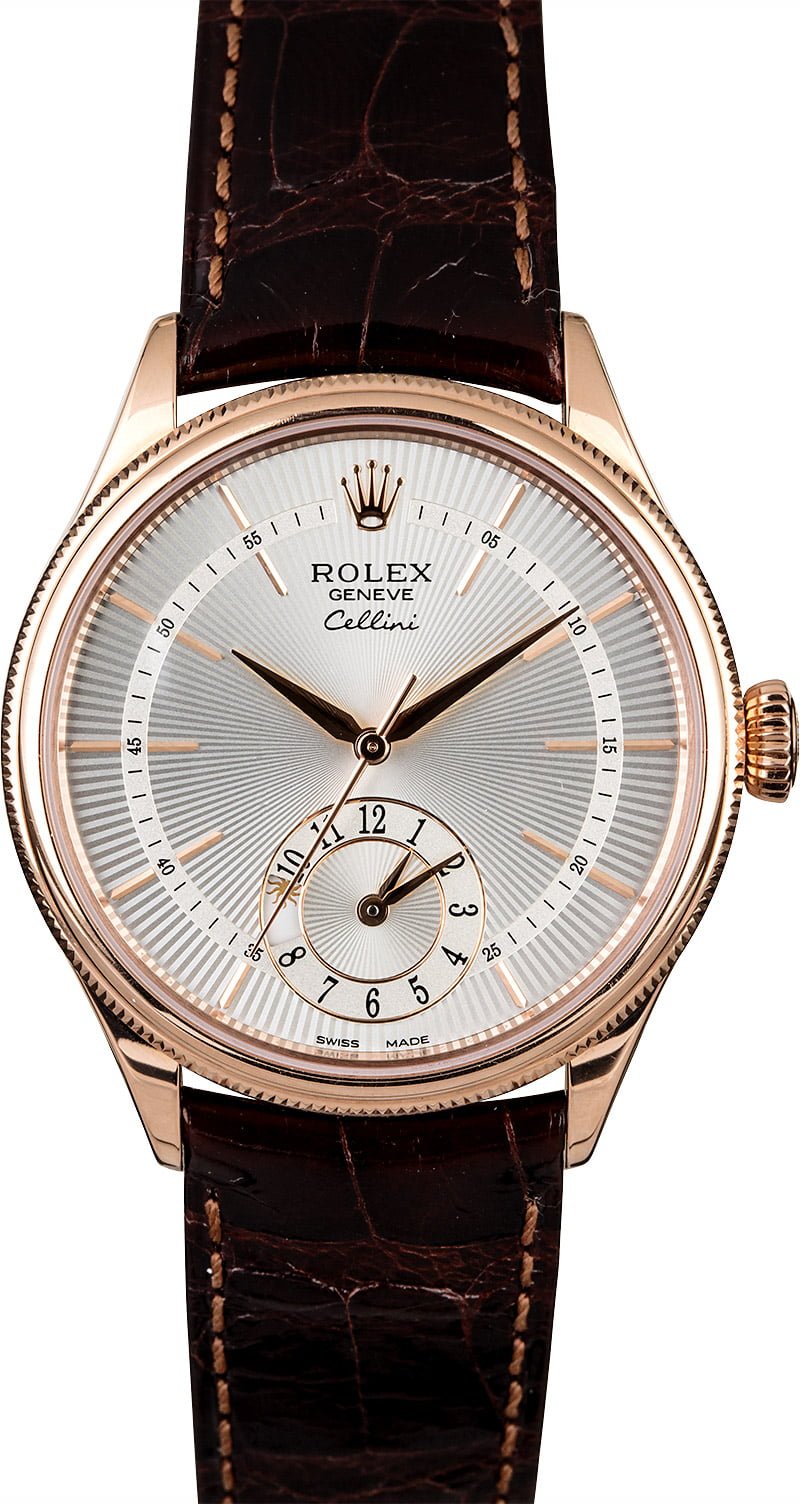
Cellini Key Features:
– Case Size: 39mm
– Materials: White gold; Everose gold
– Features Time-Only; Time + Date display; Dual-Time + AM/PM indicator; Time + Date display and Moonphase
– Dial:– Black; White; Silver; Blue; Chocolate
– Bezel: Fixed. Double Bezel (domed and fluted)
– Movement: Cal. 3132 (Cellini Time); Cal. 3165 (Cellini Date); Cal. 3180 (Cellini Dual Time); Cal. 3195 (Cellini Moonphase)
– Water Resistance: 50 meters / 165 feet
– Bracelet: Leather Strap w/ 18k gold buckle
Click here for our Ultimate Buying Guide on the Rolex Cellini.
Rolex’s Cellini series (which takes its name from the Italian Renaissance artist and goldsmith, Benvenuto Cellini), is the brand’s out-and-out dress watch collection. The four different models in the range share the same 39mm classically rounded, elegantly styled design – the only examples in the entire Rolex lineup without their trademark Oyster case.
The Cellini Time is the simple three-handed, time-only watch. Available with either a black or white dial, and cast in white or Everose gold, it is an exceptionally clean-looking piece. Its elongated hour markers are dissected by a subtle minute track and it features a pair of faceted, leaf-shaped hands.
The Cellini Date is a collection of four different watches, each with a handsome dial in a variety of colors, and a choice of either brown, blue, or black leather strap. Again available in either white or Everose gold, the watch features a large sub-dial at the three o’clock to display the date
The third of Rolex’s GMT watches, the Cellini Dual Time includes a small 12-hour disc at the six o’clock to track the second time zone, with a stylized sun and moon to act as a day/night indicator. Forged in Everose or white gold and fitted with a ‘rayon flammé de la gloire‘ guilloche dial in black, silver or chocolate.
Rolex has made a few moonphase watches over the years, but none in the brands’ recent history. The Cellini Moonphase has its celestial display as a blue enameled disc nestled at the bottom of a white lacquer dial. The full moon is depicted by a meteorite disc while the new moon is a silver ring. The two rotate through their lunar cycle, with the current phase indicated by a small arrow at the top. Driven by the Cal. 3195, the function will remain accurate for 122-years.
Finishing off all modern Rolex Cellini watches is a double bezel, one domed and the other delicately fluted, giving the watch a touch of refined elegance. Additionally, each model is fitted with a fine alligator leather strap in black, brown, or blue and completed with a traditional pin buckle in matching 18k gold.
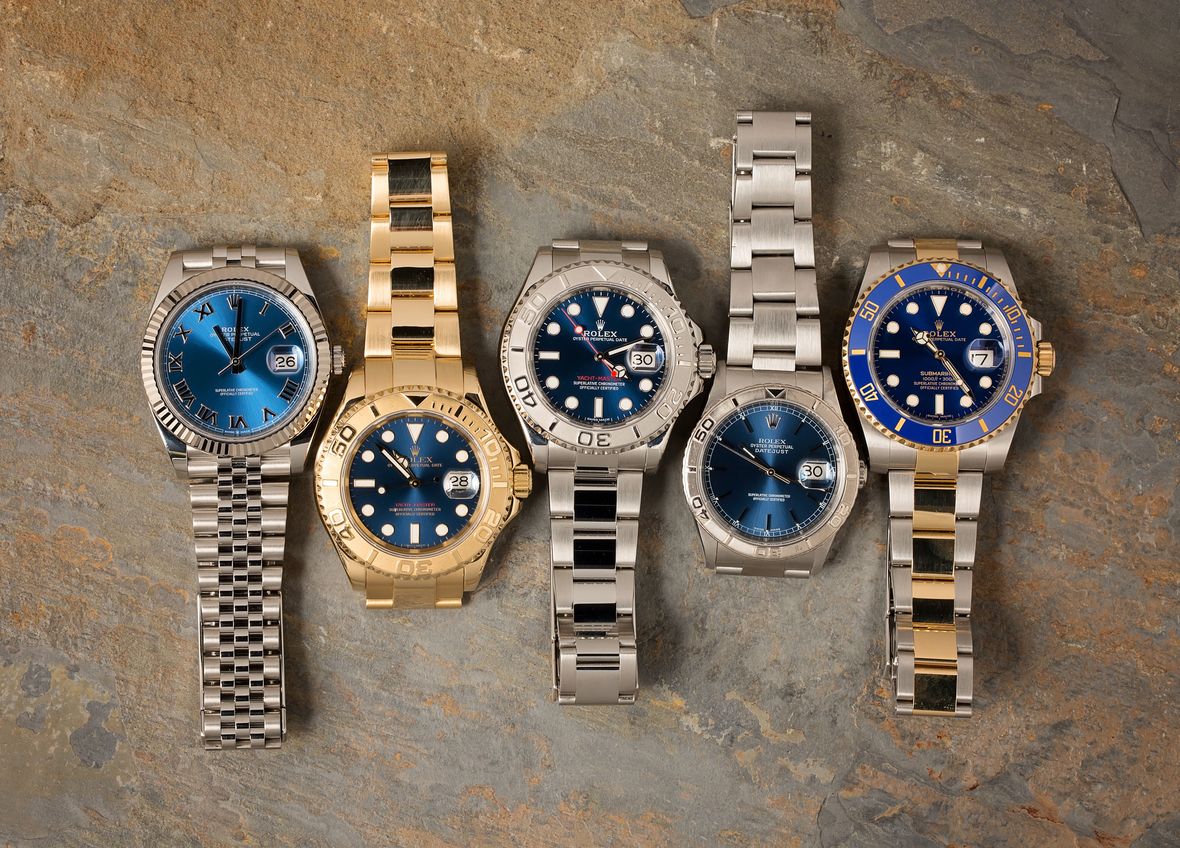
How Much Does a Rolex Watch Cost?
When purchased at a retail level, the least expensive Rolex watches start out at thousands of dollars, while the most expensive models top out at just shy of the half-million dollar mark. With that in mind, when it comes to pre-owned and vintage Rolex watches, the price range is much higher, spanning from less than $2k to well into the millions.
As of 2023, the absolute least expensive Rolex currently in production is the full stainless steel 28m Oyster Perpetual, which retails for $5,100. On the far opposite side of things are the solid 950 platinum Day-Date 40 and Daytona models that are set with diamond and other gemstones. Rolex does not even list official prices for these ultra-exclusive models on its site, but should you wish to add one to your collection, you can plan on it setting you back a few hundred thousand dollars (assuming that you are even able to find one).
Below are the starting retail prices for all of the different Rolex collections:
– Submariner: starting at $8,950
– Sea-Dweller: starting at $12,950
– Daytona: starting at $14,550
– GMT-Master II: starting at $10,550
– Yacht-Master: starting at $11,600
– Yacht-Master II: starting at $18,750
– Explorer: starting at $7,200
– Explorer II: starting at $9,500
– Milgauss: starting at $9,150
– Air-King: starting at $7,400
– Oyster Perpetual: starting at $5,300
– Datejust: starting at $7,200
– Day-Date: starting at $33,150
– Sky-Dweller: starting at $15,200
– Cellini: starting at $26,750
Now, it must be said that the brand-new retail price of a Rolex watch and the actual amount you will need to pay in order to add one to your collection today (and without spending a rather lengthy amount of time on a waiting list) are two entirely different values. Most of Rolex’s most popular models are perpetually sold out at retailers, and buyers wait several years at a time just for the opportunity to buy the model of their dreams.
Therefore, many of Rolex’s current-production watches sell on the pre-owned market for values that are significantly higher than their brand-new retail prices. For example, both the stainless steel Daytona and GMT-Master II are such in-demand models that they consistently trade hands for values that are around two to three times what Rolex charges for them. Additionally, due to the way that Rolex watch prices continue to increase over the years, older models that have been around for a few decades are now worth exponentially more than what their first owners paid for them when they were purchased brand-new, despite receiving years of daily wear and use.
No Rolex watch can ever be considered inexpensive, but the price is simply reflective of the quality of the watches and the unparalleled recognition of the Rolex brand. Rolex is known for making some of the finest luxury timepieces in existence, and it is exactly for this reason why owning a Rolex watch is a universally recognized accomplishment.
And there we have our ultimate guide to Rolex’s entire collection. Hopefully, it will be helpful as you go about searching for your first (or next) Rolex watch.
